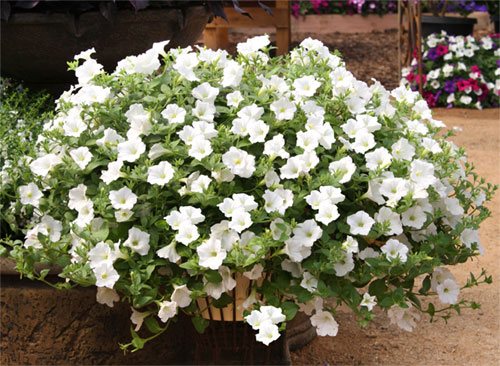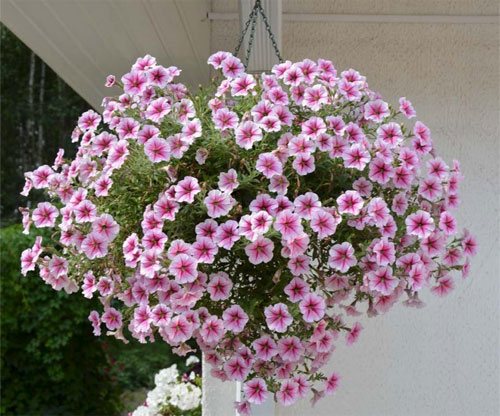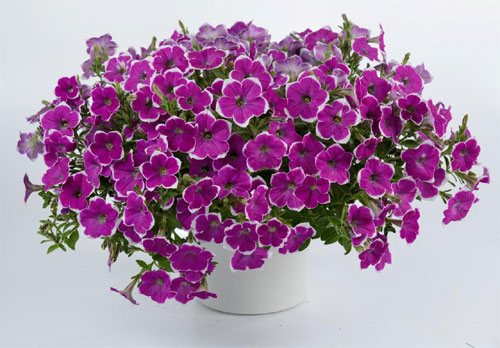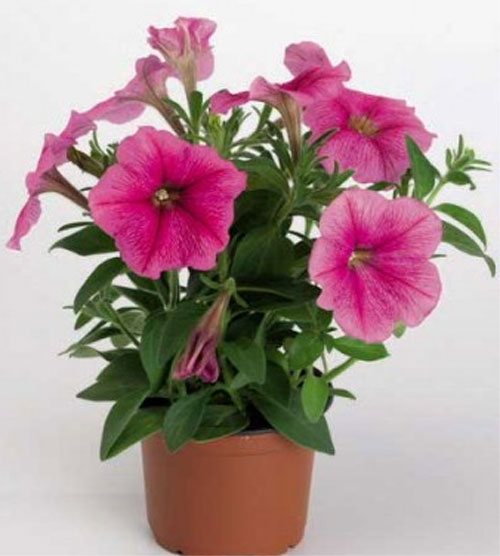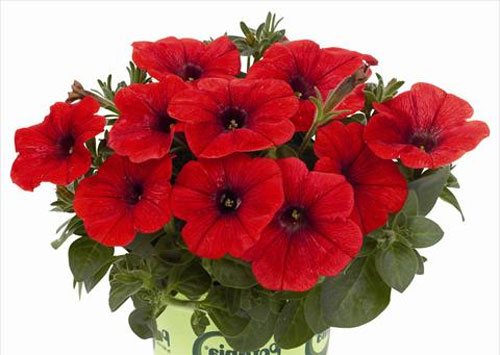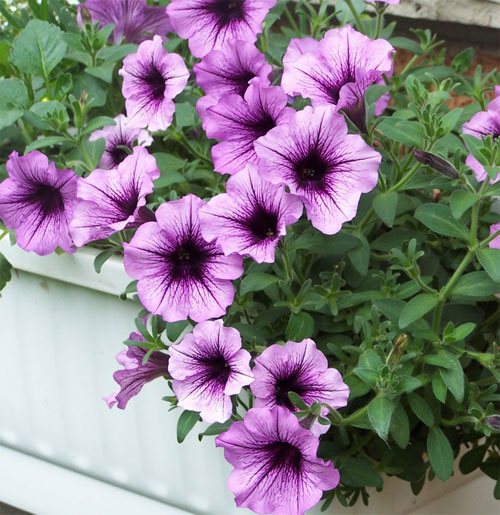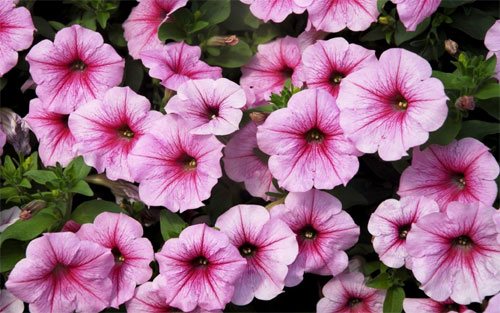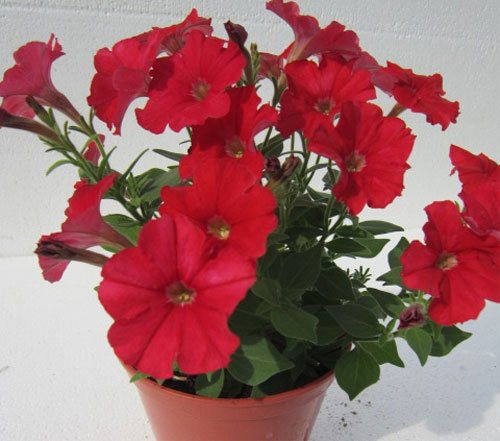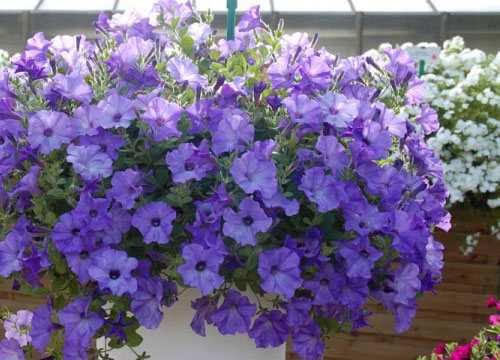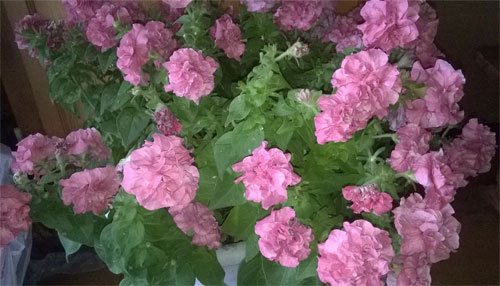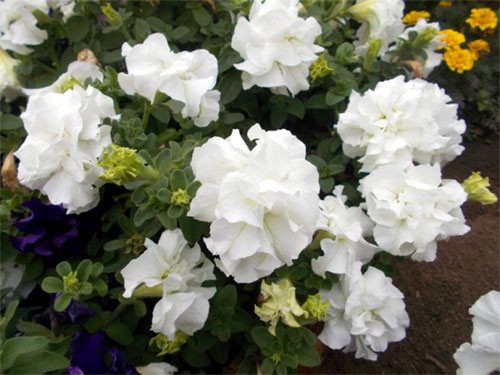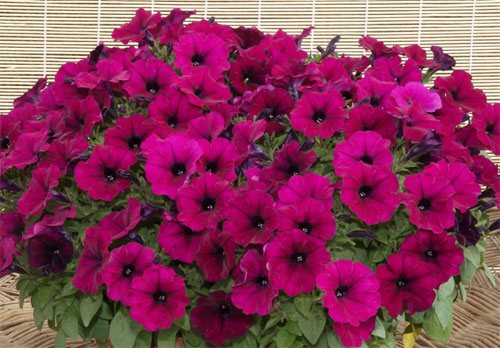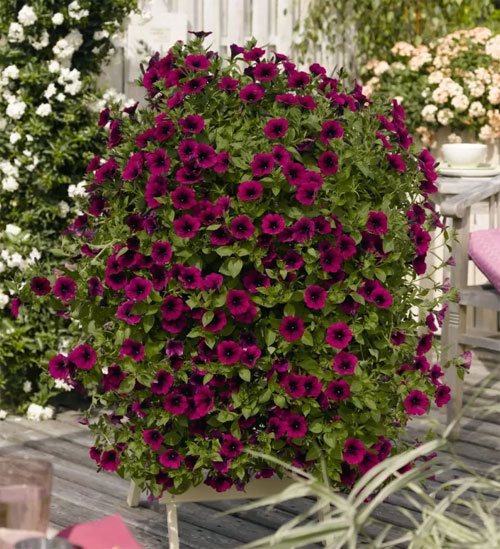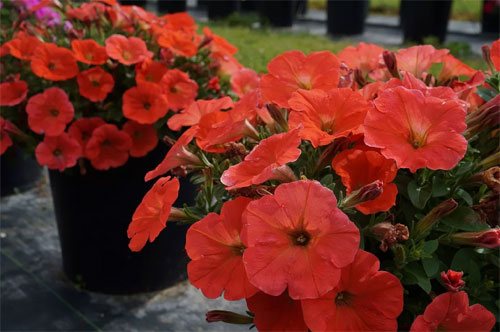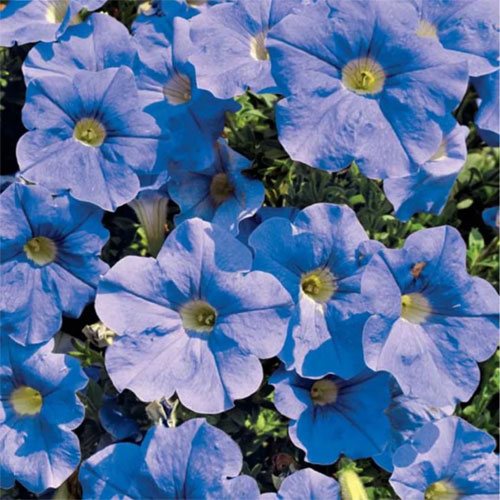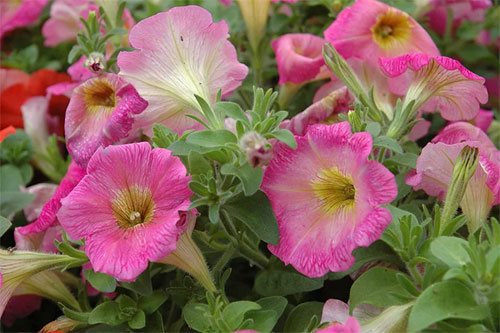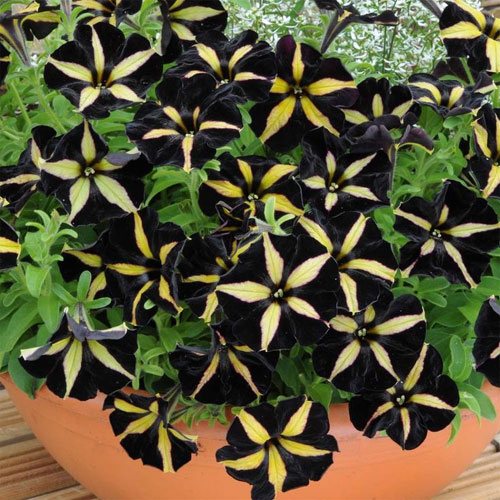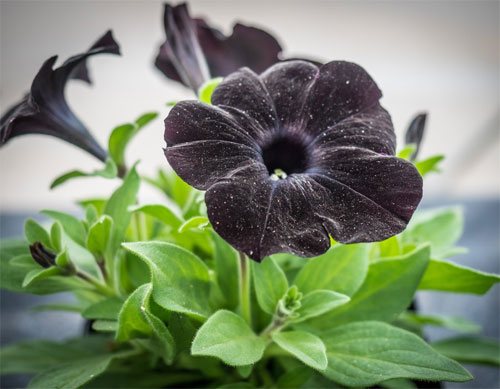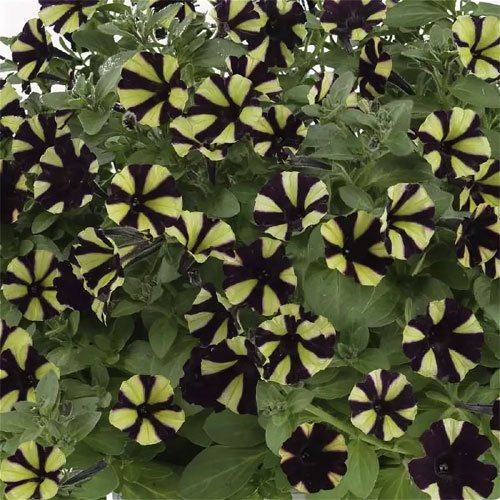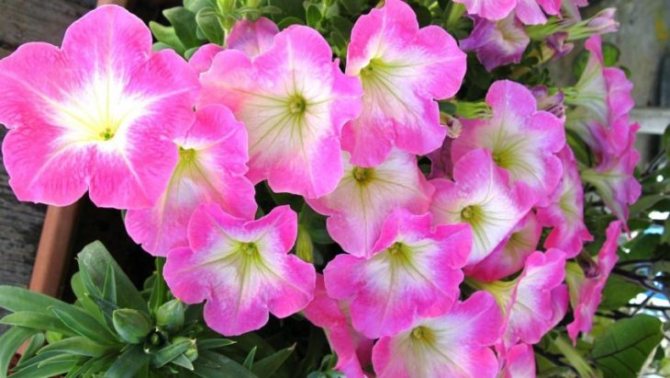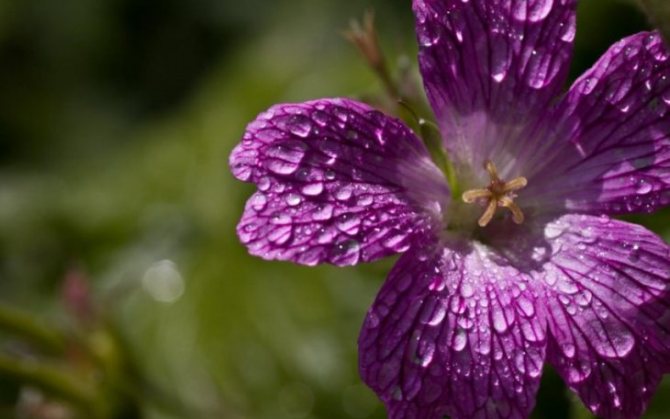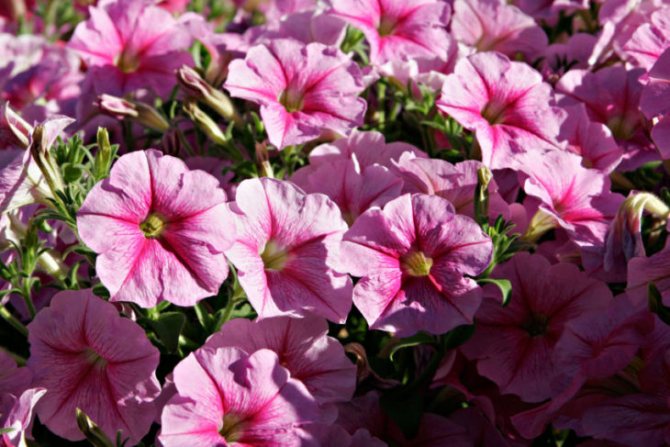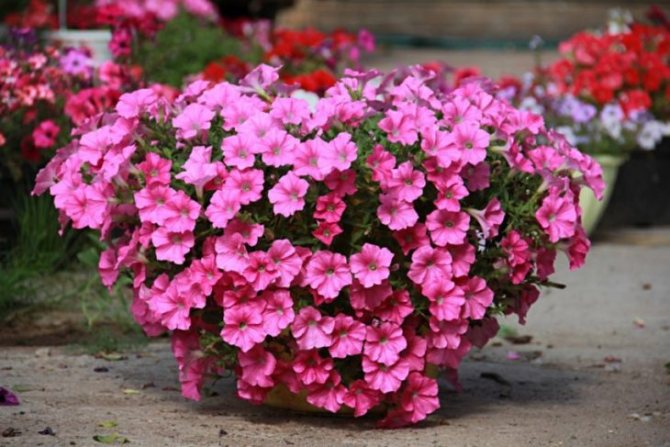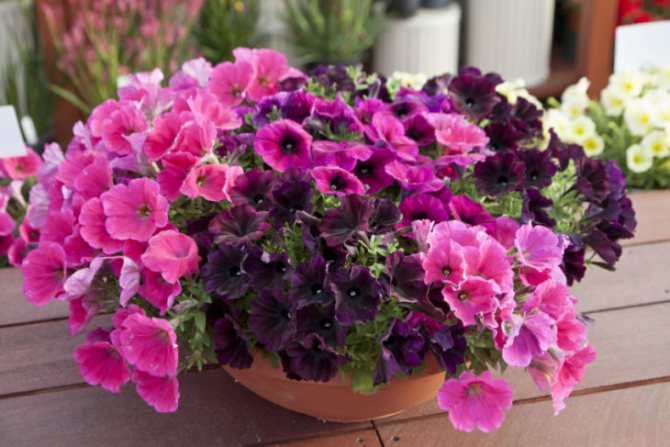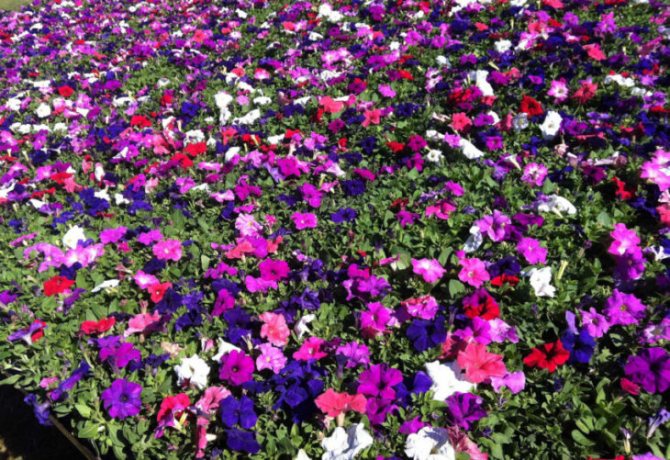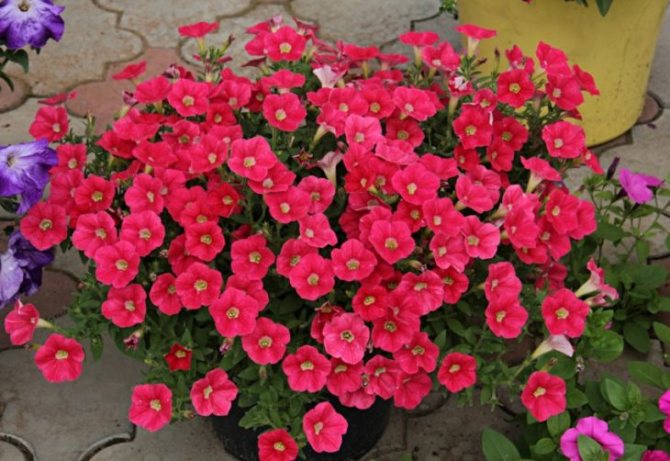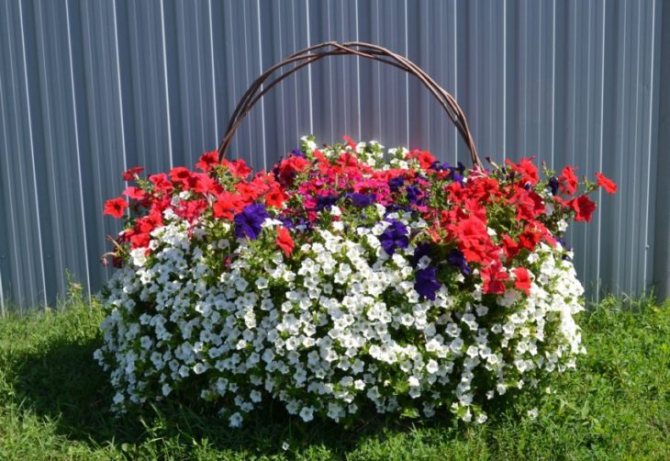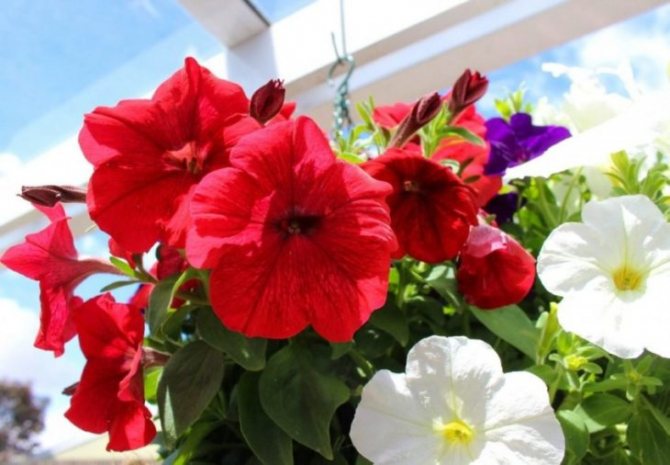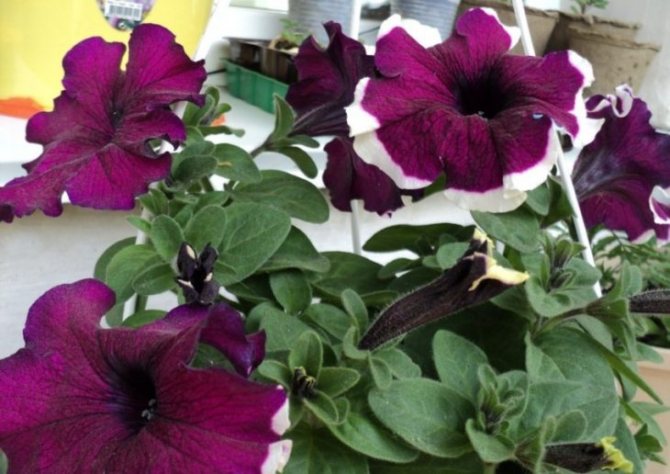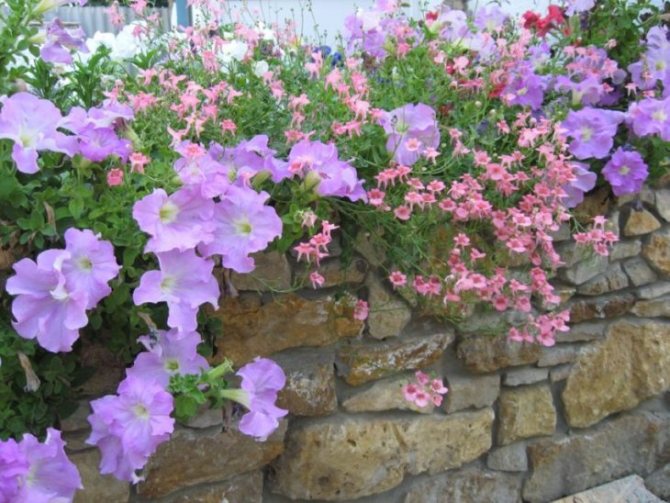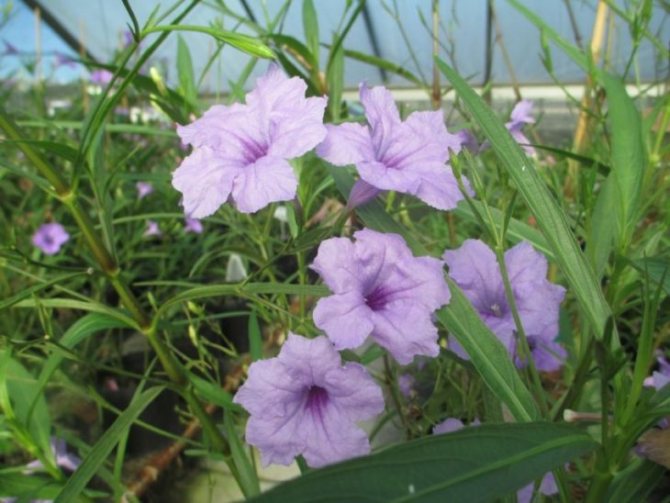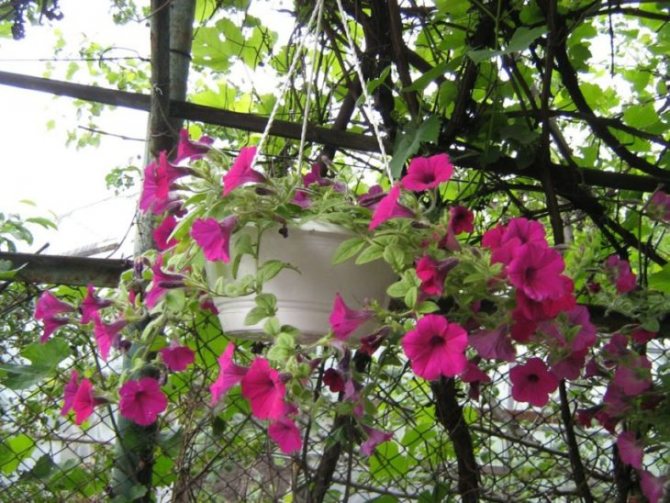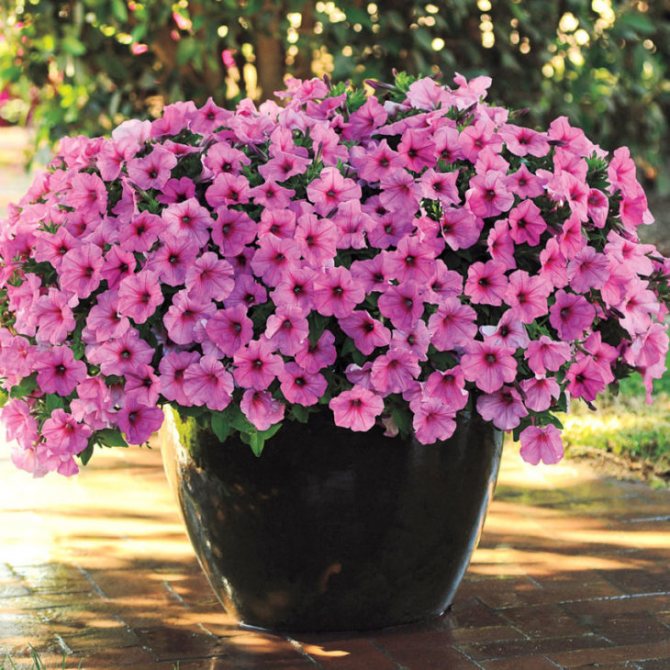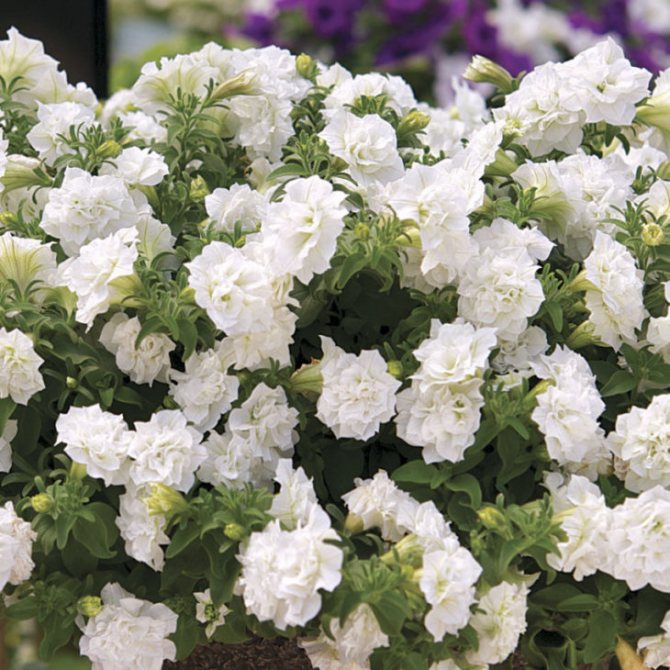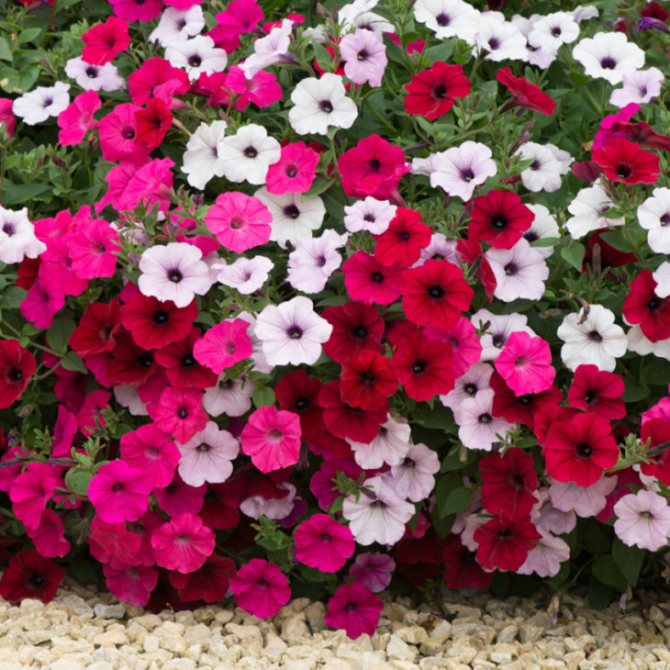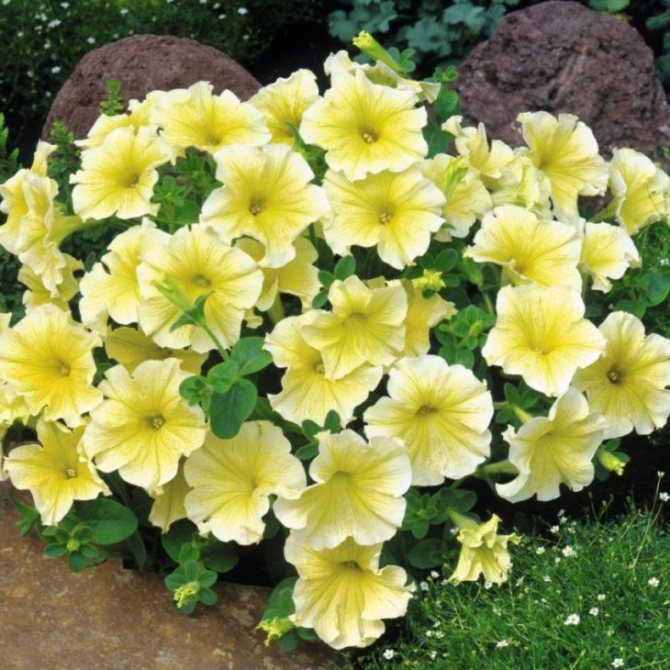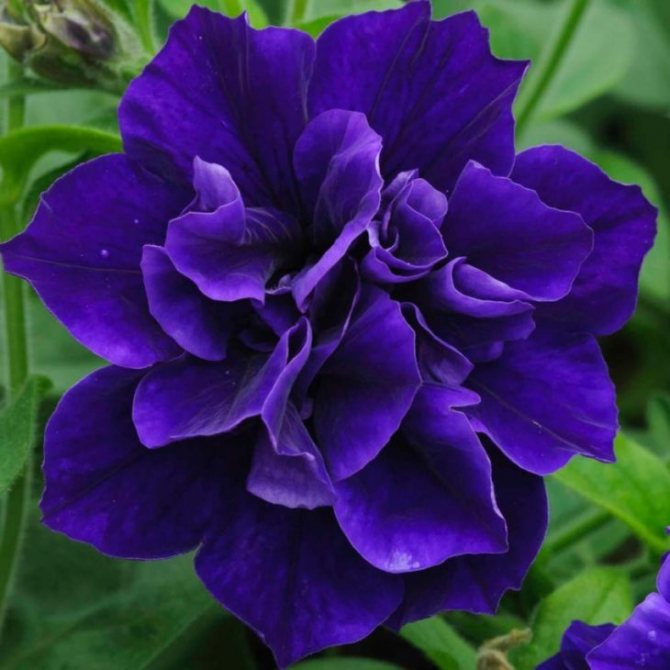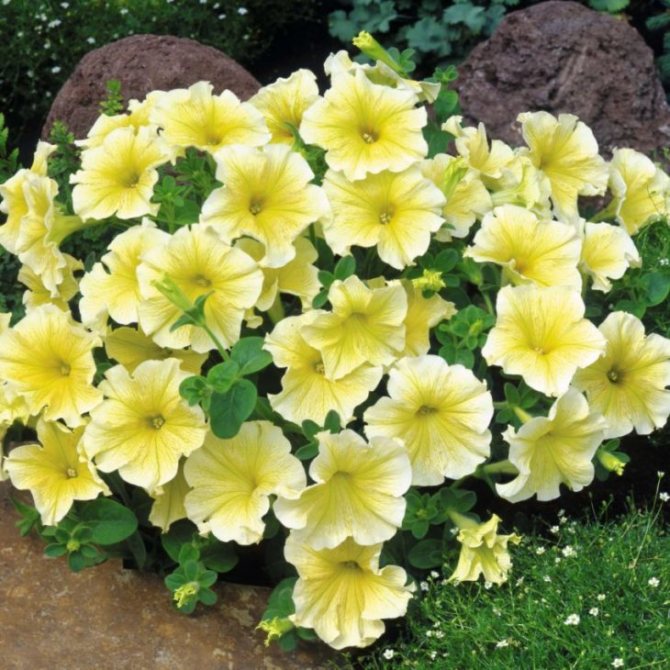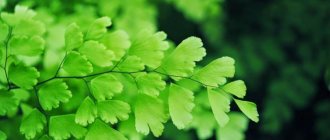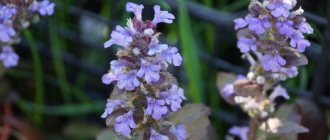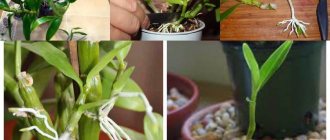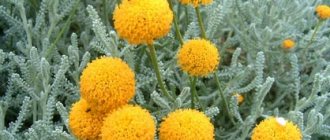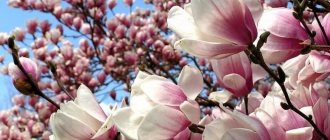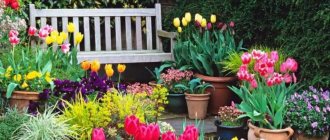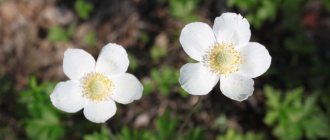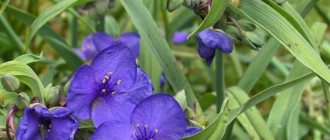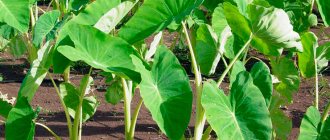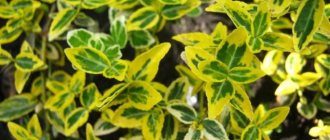Petunia is rightfully called the most beloved flower of gardeners and fans of recreation in the country. How pleasing to the eye are the multi-colored bells that open at dawn, turn their heads to the sun, and in the evening, when the gentle summer twilight sets in, a subtle spicy aroma spreads around.
Perhaps this is the simplest and most picky flower that takes root in almost any soil, and gardeners call it the most unpretentious decoration of flower beds and trellises.
Planting a petunia is simple and affordable with a minimum of skills, but you can only get good shoots and grow a strong plant if you follow the rules. About what is needed in order for the flower bed to be beautiful, lush and well-groomed, the seedlings remain strong and delight the eye with numerous abundant flowers - further.
Basics of classification
The name Petunia comes from the word petum, which these plants (and their related tobacco) received from the Indians of the Amazon basin. Two of the 40 wild species became the parents of the Petunia hybrida.
At first, the flower was grown only in southern countries, bathed in the sun. Fortunately, varieties have appeared that correspond to the climate of the northern regions. Especially long-lasting varieties with slightly smaller flowers (eg the Bravo series, and exceptionally rich flowering specimens from the multiflora group - including the Hurray and Polo series).
There is no single opinion in the classification of petunias. It is difficult for an inexperienced gardener to understand the complex nomenclature - from the variety of names and photographs, eyes run up.
A simplified classification of petunias is as follows
| In the appearance of a bush | By the diameter of the flowers and the nature of flowering | By the structure of flowers |
|
|
|
This classification makes it possible to include one plant in several groups.
Petunia hybrida is an annual hybrid obtained by crossing wild species native to South America. It is hard to believe that breeding work on petunias began over 120 years ago.
Bush
Shrub petunia is the most popular erect-stemmed variety. This category includes plants with the smallest shoot height - up to 75 cm. Flowers with edges of various shapes, 3-14 cm in diameter. One specimen is colored in several shades.
This group includes undersized dwarf petunias, the stem size of which does not exceed 15-35 cm. They are intended for open-air planting, cultivation in suspended containers.
The best undersized varieties:
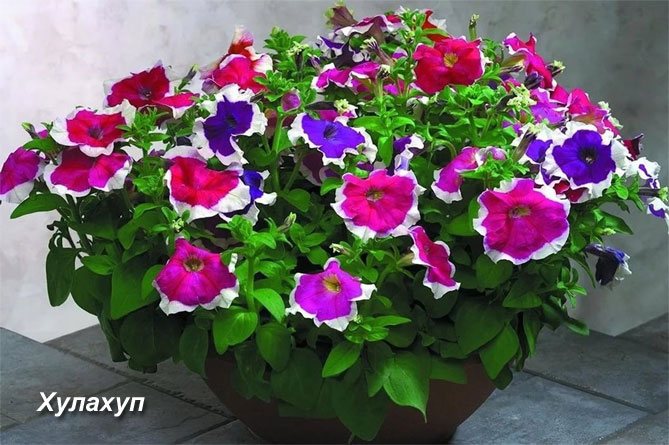
How to choose a soil for petunia
The choice of soil is one of the most important tasks for a gardener, gardener, just a fan of a beautiful well-kept flower garden, flower bed or a small garden bed allocated for planting ornamental plants. The rules for petunias, when growing and caring, include a special point - this is the choice of soil.
Maximum attention. Today, even a beginner amateur knows: in order to get a strong, beautiful bush with bright flowers, the soil is especially important.
We need a fairly thorough approach to its formation. It must comply with the following data:
- The soil must be loose.
- Have a high level of water permeability.
- The soil should be light so that the roots can breathe easily.
- The nutrient mixture should satisfy all the needs of the plant for the substances necessary for life - vitamins, microelements, organic components.
In order for the plant to be healthy and blooming, for petunia, its planting and care, a store-based universal mixture based on peat and baking powder is suitable.
Ampelny
Ampelnye are called varieties of petunias with long (30-120 cm), thin stems that fall down. Flowers, usually simple with 5 fused petals, are formed along the entire length of the shoot. The color palette is represented by specimens from snow-white to purple. There are varieties with flowers:
One plant produces flowers of different diameters.
Table. The best varieties of ampel petunias
| Title and Description | Photo |
| Snow Queen F1 |
Cascading shoots of the plant create a snow-white waterfall of flowers, 7-10 cm in size. The variety is intended for growing in open ground, hanging boxes in an apartment. Stems up to 0.8 m. The plant blooms profusely only in the presence of sufficient sunlight. It tolerates short-term drought well.
The series includes plants that form flowers of different shades: snow-white, pink, blue, coral. Stems up to 1 m. Plants are not picky about keeping conditions. Bred for planting in containers by weight or in open areas of the garden.
Variety with stems up to 1 m. The plant forms a dense green mass. The flowers are small, pink, 5 cm in diameter. A lot of sunlight and warmth are needed for good flowering. More often used to decorate balconies, loggias.
Diseases and pests
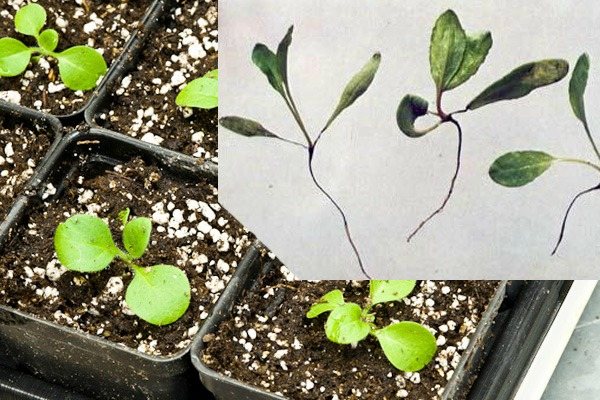

Petunias are most often exposed to diseases such as:
- Blackleg. The stem at the soil level darkens and rots, as a result of which the plant dies. Treatment: Previkur, Ridomil, copper sulfate solution. Also Trichodermil, Fitosporin-M.
- Powdery mildew. The disease is caused by a fungus. Treatment: you need to remove all infected areas of the plant along with the top layer of soil. It is also worth reducing the use of nitrogenous supplements. You can water the plant with infusion of garlic or mustard.
- Gray rot. The causative agent is soil fungus. Treatment: Reduce nitrogenous fertilizers. Remove all diseased areas. Treat with Trichodermil; Topaz; Ordan.
Pests:
- Thrips;
- Aphid.
Glue traps and treatment of plants with Decis, Fufanol help.
Cascading
Cascading petunias are also called semi-ampelous (subspecies). Unlike real ampels, their stems are stronger and at first grow upward, forming a leaf cap. The stems of cascading forms reach a length of 1.5 m, they begin to fall down only when a certain green mass is accumulated. Flowers of the same size form on the plant - 4-5 cm.
| ||
| Opera Supreme F1 | ||
| ||
| Svetlana F1 | ||
| Class | Application | Varieties |
| Ampelny | For hanging containers: flowerpots, flowerpots, balcony boxes. When planting in a flower bed, they spread along the ground. |
|
| Bush | For mixborders, rockeries, flower beds. |
|
| Cascading | Decorative compositions - "balls of flowers". |
|
Interesting series of cascading garden petunias
| Name and description of F1 hybrids | Photo |
| Bravo (Bravo) - abundant flowering, compact form | |
| Flash (Flash) - large flowers in a wide range of colors, strong growth | |
| Fantasy (Fantasy) - small flowers, compact form, low growth |
|
| Hurrah (Hurrah) - large flowers, wide range of colors, compact form |
|
| Parade Plus (Parade Plus) - the correct spherical shape |
|
| Daddy - large veined flowers |
|
| Focus / Marathon - abundant flowering, highly propagating plants, compact form |
|
| Fantasy (Fantasy) - small flowers, dwarf plants for pots, hanging baskets |
|
| Conchita - a cultivar with hanging shoots, small leaves, numerous medium-sized single or double flowers |
|
Sowing seeds for seedlings
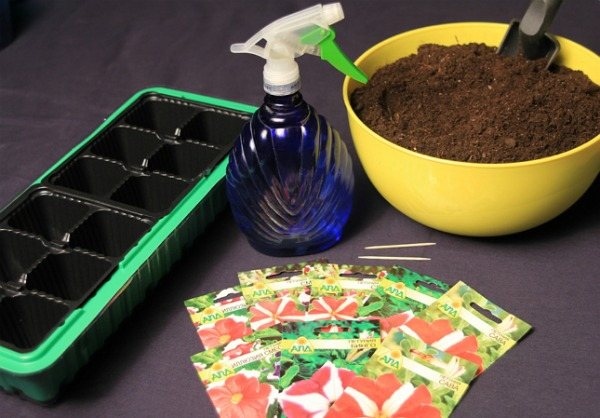

In order for petunia seedlings to grow strong and healthy, it is necessary, of course, to start from the ground. You can take ready-made store-bought soil, or you can prepare it yourself. This should be done in the fall. The soil should be loose and absorb moisture well.
It is best to use the following ingredients:
- Garden land;
- Sand;
- Peat;
- Humus.
All constituent components are taken in equal parts. The soil mixture must be heat treated before use, and also disinfected with potassium permanganate.
The prepared soil must be placed in a mini greenhouse. It is best to use a plastic cake box or a 5 liter bottle cut lengthwise into two unequal pieces. Moreover, on one side, the roof does not need to be cut off.
Moisten thoroughly or place a layer of snow more than five centimeters thick on top. Spread the seeds evenly on the snow. On the white snow, black petunia grains will be clearly visible, so you can follow the planting density.
If you get excessive density, then the seeds can be moved with tweezers or a toothpick. After that, close the lid, or cover the container with foil, glass. And leave your greenhouse alone in a warm place for about a week or 10 days.
Important! The mini greenhouse must be ventilated every day.
Grandiflora (large-flowered)
The most large-flowered petunias are up to 16 cm. Large glasses of flowers are sometimes destroyed by heavy rain or wind. Bloom sparsely in the 4th month of planting. Reproduction is seed and vegetative. Flowers are simple or double. Representatives of the large-flowered group are distinguished by a bushy form of growth (up to 75 cm), demanding on conditions of detention. Most often used for planting in flower containers. Suitable for planting under shelters, partially protected from adverse environmental conditions - heat, wind, showers.
Traditional petunias come in a wide range of colors:
Yellow varieties appeared - Sunshine from the Flash F1 series.
Also interesting are the new varieties:
- Duo Violet - with white petal trim;
- Blue and White - with large stars;
- Wimbledon Wimbledon - terry;
- Valentine's card - terry.
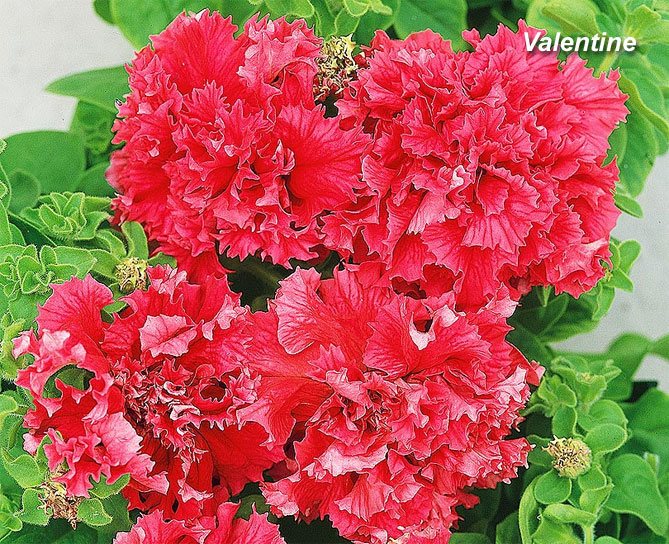

Important. Petunias also include calibrachoa and surfinia. In reality, they are not members of this genus.
Twenty years ago, the petunia's cousin, surfinia (belonging to the nightshade family), came to us, and after it a whole group of plants similar to it appeared, collectively referred to as cascading petunias. They took over the balconies, became a hit. The latter varieties have interesting colors and are better able to withstand the whims of our climate.
Disease prevention
No matter how careful the care of the flower is, it is necessary to pay attention to measures to prevent the appearance of diseases and pests. The tricks are simple and easy:
- The use of the optimal soil composition, in particular, will have to be monitored so that the soil is not over-acidified and heavy.
- When planting, it is extremely important to maintain the distance between the plants.
- Timely watering, feeding and control of the nitrogen level in the soil.
- Avoiding stagnant moisture between plants.
If you follow these simple recommendations and practical tips, the most modest plot or crumbled flower bed will delight you for a long time with lush, exuberant flowering.
Floribunda (profuse flowering)
The group includes varieties that are the least demanding on weather conditions. Can grow in full sun and partial shade. Plants are 0.2-0.3 meters high. Flowering begins 3 months after planting. Reproduction is generative. The size of the flowers is 7-10 cm.
| Group | Application | Varieties |
| Grandiflora | For planting in containers |
|
| Floribunda | For the design of garden paths, flower beds, decorative stripes along the roads. |
|
| Multiflora | For flower beds |
|
| Milliflora | For flower beds, borders, containers |
|
The best varieties of red petunias in design
Red petunias are very often used in urban landscaping, because their bright, defiant appearance immediately attracts the eye. But in gardens, red shades are best used sparingly. This color has an exciting effect on the nervous system and can get boring over the summer with daily contemplation on the site.
Red petunias will be appropriate, first of all, in the ceremonial area. At the same time, adding bright yellow colors to them will only enhance their expressive effect. In order to cool the ardor of fiery red a little, it is better to add plants with silvery foliage (cineraria, dichondra, plectranthus, etc.) or plants with small white flowers (bacopa, alissum, gypsophila, etc.) to such petunias.
Next to reds, petunias with white or beige ivory flowers also look good. It is better not to add annuals with blue and purple colors to the company to red petunias, since such combinations give the impression of being heavy and gloomy.
Terry petunia Valentine.
Terry
Plants are 0.3-0.6 m high. A distinctive feature of the inflorescence is the petals of various shapes (with wavy, uneven edges). The color palette ranges from pure white to purple. Among the varietal varieties, there are plants with huge and numerous small flowers. The variety of varieties allows you to use them for decoration:
The best varieties of terry petunias
| Name and description of petunia | Photo |
| Pirouette F1 |
The group brings together many varieties. Outwardly they resemble a bush. The stems are strong. The flowers are 10-15 cm long. The edges of the petals are with deep cuts. The petals are solid or multi-colored. Long-lasting, abundant flowering.
Petunia with stems, up to 45 cm high. Grows in the form of a bush. Long flowering. Flowers 7 cm in diameter, pink. Well suited for outdoor cultivation - in flower beds, terraces. Looks beautiful in containers on loggias, balconies.
A small bush, 0.3-0.4 meters high. White flower petals form a lush "ball". The diameter of each flower is about 8-12 cm. Flowering lasts several months. The variety is excellent for planting in open-air flower beds.
What to do for lush bloom
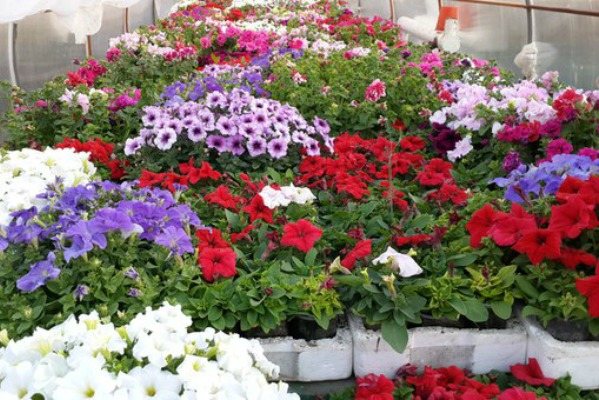

In order for the petunia to bloom long and plentiful, you should regularly take care of it and take care of it.
To get lush bushes, they must be formed. To do this, you need to pinch them. And it is necessary to pinch not only the main stem, but also all other shoots. Together, pinching two shoots will grow.
As soon as the shoots reach a length of 10-15 cm, they should be pinched again. The more often you pinch the plant, the more magnificent the bush will be. It must be remembered that with such an intensive growth of shoots, petunia must not be forgotten to feed with fertilizers. Otherwise, the plant will be depleted and lush flowering will not work.
It is also necessary to monitor the faded buds and remove them in time so that they do not form seeds. A lot of energy is spent on the formation of seeds. And of course, water the plant in a timely manner.
Petunia simple
The group includes the largest number of plants. The similarity lies in the fact that all form simple flowers in the form of a funnel with fused petals. There are varieties with firm stems that grow in the form of bushes. There are also species with creeping shoots. Flowers of different colors, monochromatic and bicolor. They are widely used in landscape design. Simple petunia is grown in Siberia and in the south.
The best varieties of petunias suitable for hanging planters with plain flowers
| Angora F1 | |
| |
| Sonata F1 | |
| |
| Title and Description | Photo |
| Mashenka |
Plant with pinkish flowers 6-7 cm long. Stems 0.8 m each. Forms dense greenery. Mainly used to decorate balconies. It blooms profusely only when planted on the sunny side.
A variety with many flowers, with shoots spreading on the ground or hanging down to 1 m in length. The plant grows no more than 0.2 m in height. It blooms even in bad weather. Grown in the open air, indoors. The color of the flowers is varied. Size - 6 cm.
The series unites plants with small flowers (5 cm) of various colors: white, purple, pink. Stems up to 1 m. Grows well hanging in pots. Looks good when planting in open areas, flower beds, here their height is no more than 0.25 m. Shoots form a flower path.
Some of the most unpretentious petunia varieties:
- Coral foam,
- Snowball,
- Dolce Limoncello F1.
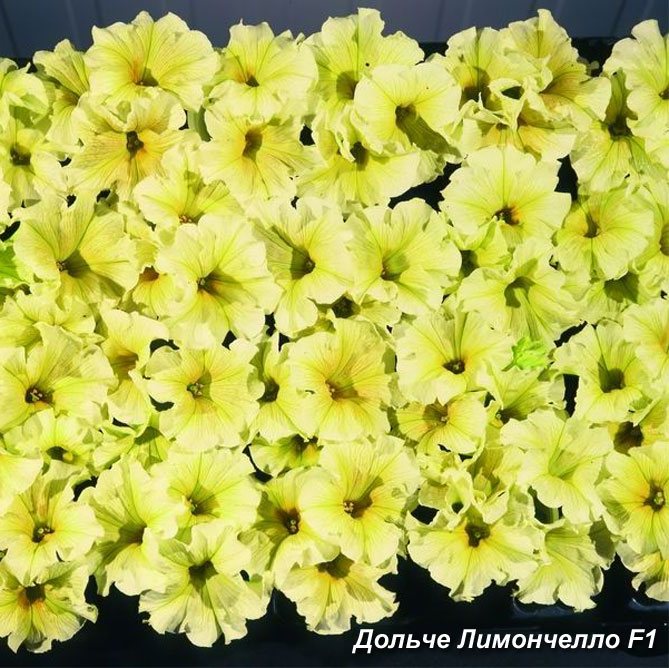

Problems of growing petunias
Yellowing of seedlings
The disease with uneven yellowing of the upper leaves (the veins remain green) is called chlorosis. This is an iron deficiency. The causes of chlorosis:
- Soil alkalization;
- Bad soil;
- Abundant watering.
The plant needs to be treated with Ferovit or Chelate iron.
Yellowing of the lower leaves occurs from over-watering or lack of nitrogen. It is necessary
Reduce watering and apply nitrogen fertilizers.
Rolling the leaves
The reasons why leaves curl on petunia seedlings:
- Unsatisfactory growing conditions;
- Viruses and pests.
With the improvement of growing conditions, the seedlings will return to normal, if pests attacked, aphids or thrips can be destroyed by Decis or glue traps can be placed. But if the plant is damaged by a virus, then it will no longer be possible to save it. The main thing here is to prevent the spread of the disease to other plants.
Seedlings of petunias grow poorly
Seedlings may not grow well for the following reasons:
- Poor quality soil. By changing the soil, the problem can be solved.
- Small container. After transplanting the seedlings into a larger container, the seedlings will begin to grow again.
- Insufficient nitrogenous fertilizers. You need to fertilize.
If all the shortcomings are eliminated, and the seedlings still grow poorly, stimulation is needed. We use vitamins B1 and B12 for this. An ampoule of one of the drugs should be diluted in a glass of warm water and the petunia leaves should be sprinkled with the resulting solution. It is necessary to alternate vitamins after 7 days and the seedlings will grow.
Vegetative petunias
Most petunias are propagated by seed. But there are hybrids that can multiply using cuttings. Such varieties are called vegetative. As a rule, these are small plants with hanging or erect stems. Flowers are simple and double, the color is varied.
Varieties of vegetative petunia
| La Gioconda F1 | |
| |
| Corduroy F1 | |
| Title and Description | Photo |
| Tumbelina Maria |
Ampel grade. Mainly grown in hanging containers. Stems 0.5 m long. Petals are terry. Bluish lilac color. Flower diameter 6 cm.
Low bushes of 0.4-0.5 m. Densely branched. There are many flowers. Color - burgundy purple. Used for planting in pots, flowerpots.
Grows in the form of a small bush. There are many flowers. The color is bright orange. Long flowering. The variety tolerates temperature extremes. Designed for planting in suspended containers, flower beds.
Summer petunia care
Petunias require constant care throughout the summer.
Watering. As the soil dries up, the flowers need to be watered. Watering is best done in the evening. After watering, the soil near the plant must be loosened.
Top dressing with fertilizers. A week and a half after planting petunias, you need to carry out the first feeding with nitrogen-containing fertilizer. After another couple of weeks, for better flowering, you need to feed it with phosphorus and potassium fertilizer. Petunia responds well to feeding with ash.During the entire flowering period, nitrogen fertilizers must be alternated with phosphorus and potash fertilizers.
Removing dead buds... Withered flowers must be removed in a timely manner. Since this spoils the beauty of the bush as a whole, and takes away excess nutrients.
New, interesting varieties
In the assortment of balcony and rabatkovy varieties, in recent years, many interesting varieties have appeared that deserve attention. There are many new options with black flowers, but growers are more interested in new products for the mass market.
| Cardinal's Surprise | |
| |
| Plus Papaya | |
| |
| Title and Description | Photo |
| Rhythm & Blues in Germany has been declared the "Balcony Plant of the Year 2013". The vegetatively propagated Rhythm & Blues petunia has medium-sized dark blue flowers with a white border and a cascading shape (shoot length 40 cm). Petunia is bred by an American company. | |
| Blue Stardust is a blue-flowered plant with white transverse stripes that create a star. |
|
| Sky Blue is characterized by a more "blue" color. |
|
| Pink Lemonade (Pink Lemonade) from the same group - the throat of a lime-colored flower, the edge is pinkish. |
|
| Phantom (Phantom) - reproduces vegetatively, with unusually colored flowers and a compact, hemispherical bush shape. The flowers are black and yellow. |
|
| Mystical Wicked Purple is a pink-flowered petunia with a green periphery, resistant to iron deficiency chlorosis. | |
| Black Ray (Black Ray) - the variety propagates vegetatively, with black flowers. |
|
| Bicolor Black - yellow-black, rather small flowers. |
|
| Rim Magenta - relatively small, numerous purple flowers with a yellow border. | |
| Cascadia (Cascadia) - with a compact shape, small pinkish-red flowers with a yellow throat. | |
| Lime Green - with yellow-green flowers. |
|
| Lime Bicolour - yellow-green inflorescences with a pink tint. |
How to beautifully plant petunias of different colors (planting patterns)
Plants scattered around the site give the landscape a casual look. To reveal the beauty of ornamental crops, you need to choose the right combination. Multi-colored solutions of the same type are planted according to schemes. Design techniques will help you get original options.
Round flower bed
A stylish composition of petunias in several shades will become a bright spot of the landscape. Against the background of a green lawn, a combination of red and blue varieties looks advantageous. In huge flower gardens, patterns are often created from plants - from standard lines to geometric weaves. Contrasting transitions from bright to muted look luxurious. So that the structure is not flashy, no more than 4 tones are used. The combinations are successful:
- purple with white and blue;
- red with burgundy and pink;
- shades of different intensities from the same range.
Decoration of a large flower bed with petunia. In pink tones Source
Raised
Due to the vertical walls of the container, the flower garden looks original. The center of the composition is ampelous petunias, which hang down in a light cascade. Variants of white, complemented by pink or blue, look luxurious. In landscape design, you can use plants of the same color, but different shapes of buds - simple and double.
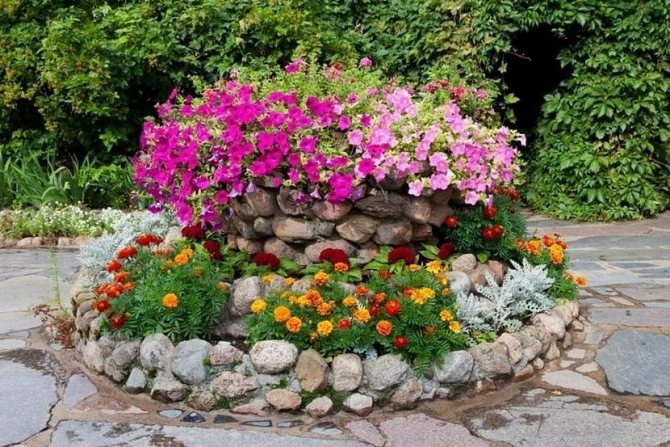

Bright rock garden Source
Landing pocket
The original mini-flower bed is suitable for an area with a cobbled courtyard. Small places are left between the plates in which petunias are planted. Large-flowered bush hybrids quickly fill the gaps with the ground. Options from 2-3 related or contrasting shades look beautiful. Red and white can be complemented by pink, while blue is luxurious in a duet with light tones.
Gravel garden
A popular solution for petunias in landscaping gives the site a well-kept look. Plants are planted in raised beds, the paths around are sprinkled with gravel of medium fraction.Against the background of a gray base of stones, it is appropriate to use varieties with rich shades:
- Bordeaux;
- purple;
- blue;
- lilac.
A miniature gravel garden on a paved path in landscaping looks elegant and stylish. Plastic frames for petunia flower beds repeat the size and shape of the tiles. Low bush varieties of bright colors are planted in free space. Elements with flowers on the paths alternate in the form of a checkerboard with small stones of different fractions.
Flower ball
An unusual hanging flower bed, which will become a decoration of the landscape. Petunias are planted in special hemispherical nets with large cells. As they grow, the bushes are pruned, giving the structure the shape of a ball. For the plant base, crops with simple flowers are chosen. Plants look luxurious in two related shades - pink with red or blue with blue. In the composition, rich scarlet and lilac can be complemented by strict white.
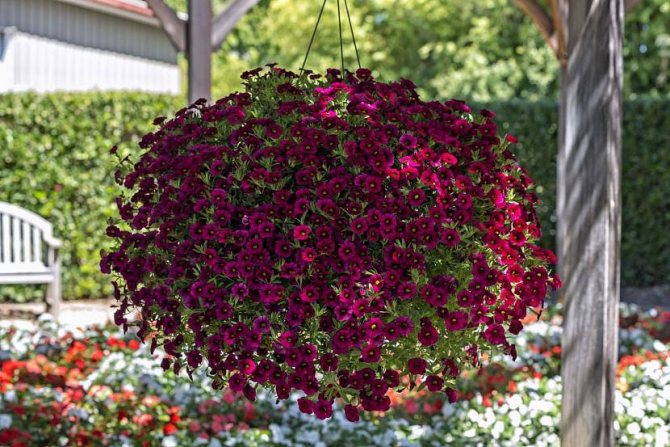

Burgundy petunia Source stroy-
Testimonials
I stopped planting terry varieties, the flowers are certainly beautiful, and the bushes are crooked, oblique, sticking out in different directions. I won't plant super-cascading ones either - bushes have sprung up. Frillitunia "Butterfly" - beautiful branches, large, and the bush is loose, empty. This year I am looking for small-flowered varieties.
I really like supertunia. I plant one bush in a 10 liter pot. Last year I sowed 2 bushes - it was a bit crowded.
I really liked the Double Cascade Pink variety, planted in open ground and pots. Went great everywhere. The bush is stocky, dense and compact, in pots up to 25 cm high, in the ground - up to 30 cm. Flowers up to 15 cm, 5 pieces at a time. Pleased with flowering until October. Of those you didn't like - the Snow Globe is a bald bush, it has fallen apart, although it blooms profusely, it looks ugly.
My favorite is the terry Duo. Bushes are compact, rich in color, in a mixture of several colors. Looks very nice, and even stood before the frost!
In total, several thousand varieties and hybrids of petunias are known. Simple or double flowers are painted in all colors of the rainbow, from snow-white to almost black. Below are presented to the reader's attention the most beautiful and unpretentious varieties of petunias with photos and descriptions.
Gardeners can choose a plant to plant in a flower bed, planter, or hanging basket. Some flowers form neat lush bushes, others grow in colorful carpet or fall in bright waves.
How to choose the right place
The beauty of the site depends on choosing the right place to grow the bushes of this wonderful ornamental plant. In order to get good results from your work, you should remember simple things:
- Any type of plant requires at least five or six hours of full sunlight and heat during the day, but a little shading will not be a negative factor.
- Before planting in the selected area, it is best to carry out drainage measures, but it will be very comfortable for petunias to just well fertilized soil.
- For planting in vases, it is necessary to use a mixture of peat, compost from pine bark, waste of coconut fibers, sand, and screening.
Undersized
This group of varieties is called bush petunia, which forms lush bushes, no higher than 30 cm. Plants are planted along the paths, in the foreground, flower beds, in small flowerpots.
Shrub petunias are an extensive group of varieties and hybrids, including small-flowered forms (Multiflora), large-flowered (Grandiflora). In petunia multiflora, the diameter of the flowers does not exceed 3-4 cm, but the abundance and long flowering duration compensates for this disadvantage.
Varieties of low-growing small-flowered petunias:
Lambada is a bush 25 cm high, early (8 weeks after germination) and blooms profusely, colors: pink, red, burgundy.
Hurray Krasnaya Zvezda - the height of the petunia is up to 30 cm, the diameter of the flower is 6-7 cm, the color is contrasting white-red.
Ur Blue is a blue petunia species reaching a height of 30 cm.
Picabella is an unpretentious group of miniature petunias, 20-25 cm high, flowers of a simple shape, 3.5-4 cm in diameter, pink, blue, lemon, purple.
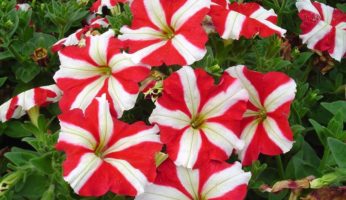

Other undersized groups of petunias:
Amore Mio is an unpretentious plant, with a bush size of 35 by 50 cm, flowers 5 cm in diameter, colors: red, white, pink.
Mini-petunia Cinderella is a dense bush up to 20 cm in height, flowers are 4-5 cm in diameter, red, purple, pink.
Dwarf petunia Mambo - bush height up to 25 cm, large flowers - up to 7 cm, the color of the petals is pink, purple, violet.
Horizon - plant height does not exceed 30 cm, flowers 6-8 cm in diameter, white, scarlet, pink.
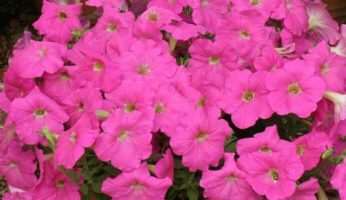

How to feed a flower
Despite the fact that petunias in the garden can be found in almost every more or less well-groomed area, the flower is not as easy to care for as it sometimes seems. In order to achieve the effect of feeding, it is necessary to carry out it correctly and directly with those drugs that are recommended by experts. Petunia requires several types of feeding.
- Liquid mixtures and fertilizers. The most popular, they can be purchased in the retail network in the form of concentrates; should be diluted in the right proportions, in strict accordance with the instructions and recommendations. The most famous mixtures for stimulating flowering are Garden of Miracles, Ideal, Bona Forte, Uniflor.
- The use of dry fertilizers does not differ in any peculiarities; they are similarly bred according to the instructions. This is Plantofol, Master, Kemira Lux. Dissolution is also carried out only according to the instructions, watered once a week, but more frequent feeding is possible, with a significant decrease in the concentration of the solution.
- Long-term fertilizers are long-dissolving granular compositions - Ethisso, superphosphates, nitroammophoska. Basically, they are brought in dry, and for a beginner grower, they present a certain difficulty.
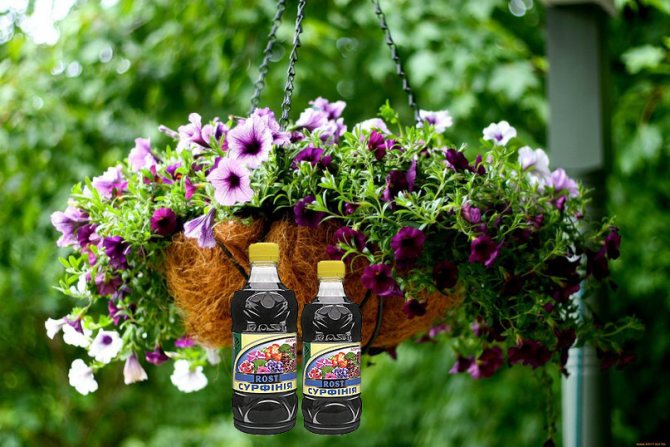

In the vast majority of cases, petunia flowers require phosphorus, potassium and nitrogen when planting. In anticipation of flowering, excellent results will be obtained by using potassium-phosphorus fertilizers - Kemira Lux and Agricola.
For flower beds
For placement in a flower bed and in a flower garden, not only spray petunias are suitable. The cascading form of the plant looks impressive, when long shoots evenly cover the ground, forming a multi-colored carpet.
A popular variety of petunia for flower bed decoration is multi-flowered. The shoots of the plant can grow up to 35-50 cm, forming a lush spherical bush. There are so many buds on the plant that sometimes the foliage is not visible.
Varieties and hybrids:
Ferrari - bush height up to 20 cm, width up to 50 cm, flowers 6-8 cm in diameter, scarlet, do not lose their decorative effect from rain and wind.
Kaliffo (hybrid) - velvet flowers up to 6 cm in diameter, colors: blue, red, burgundy, cherry, all flowers with a white border around the edge.
Elegy - the dimensions of the bush are 25 by 60 cm, the branches are simple, 7 cm in diameter, painted in a light purple hue, with a lightened neck.
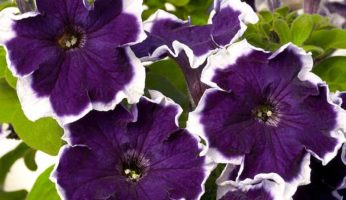

An asterisk (a mixture of shades) - petunia, up to 30 cm high, flowers up to 8 cm in diameter, the color of the bud is a contrasting combination of white with red, pink, purple.
Jolly is a bush petunia with a lush bloom of white, blue, scarlet, pink flowers.
Sophistry Blackbury - the height of the bush is 40 cm, the flowering is abundant, until the very frost, the color of medium-sized flowers is burgundy-black, the structure of the petals is velvet.
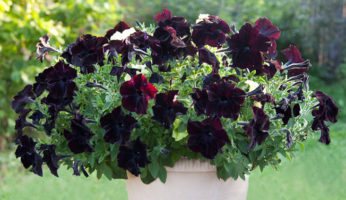

Transplanting petunias to a permanent place
When the air temperature warms up, the seedlings of petunias are planted in a permanent place. Best of all, petunias will take root in a new place if they are planted in cloudy weather. It is necessary to prepare pits about 10 cm in size, and place the seedling there along with a lump of earth.
The distance between the bushes should be from 20 to 35 cm, depending on the variety.
Unpretentious
The most unpretentious are small-flowered bush and ampelous petunias.They do not suffer from summer temperature changes, quickly restore the shape of the petals after rain and wind, and bloom profusely until late autumn.
Storm is a group of varieties of large-flowered petunia, bred recently. Plants are distinguished by bright, long flowering and resistance to adverse weather conditions.
Multi-flowered petunias are easy to maintain and endure the vagaries of the Russian climate. Interesting varieties:
- Alderman (blue);
- Angelica (light yellow).
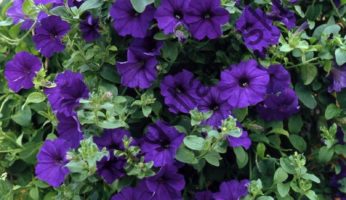

The best red petunias: varieties and hybrids
For those who have only recently become interested in floriculture, red petunias are a completely ordinary phenomenon. However, it took breeders over a hundred years to achieve true red. The first pure red petunia was marketed by the famous American company Pan American Seed only in 1953. This petunia was called "Comanche" and belonged to the multiflora series (multi-flowered).
But since Western novelties came to us with a great delay, I remember well the time when it was incredibly difficult to buy a real red petunia, because it was given off as raspberry and purple colors, sold under fictitious names with the word "red".
But as soon as professional seeds became available in our country, it became possible to purchase real red colors of Western selection. Today, red can be found in almost every line of hybrids. It is usually denoted by the word Red. A slightly different shade of red can also be referred to as Coral or Scarlet.
Usually red petunias are solid or have a contrasting white neck deep in the flower. In bush petunias, red-flowered specimens are found in such popular series as:
- Mambo;
- SUCCESS! ® 360 °;
- Duvet;
- Bravo;
- Eagle;
- Falcon and others.
These lines form low spherical bushes, 20-25 centimeters high, covered with large flowers 10-12 centimeters in diameter.
With large flowers
The diameter of a flower in large-flowered hybrids can reach 14-16 cm. Often hybrids have a flower not only large, but also double or with a fringe along the edge of the petal. Only a few such huge buds open on the bush, in contrast to the small-flowered forms of petunias strewn with flowers.
Examples of hybrids and varieties:
Nana is a branched bush, 40 cm high, flower size up to 10 cm, colors: pink, lemon.
Falcon - a hybrid characterized by early flowering and large flowers (up to 12 cm in diameter), colors: red, pink, blue.
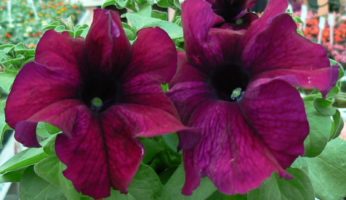

Spherica - plant size 20 by 30 cm, lush bush, flower diameter 11 cm, colors: pink, pink with a white center, crimson with a white center, white, blue, lilac.
Aphrodite is a flower, 11 cm in diameter has a fringed edge of the petal, the color of the flower is salmon.
Triumph giant - petunia, up to 40 cm high, flowers with a wavy edge of petals, up to 15 cm in diameter, colors: pink, scarlet, pale lilac.
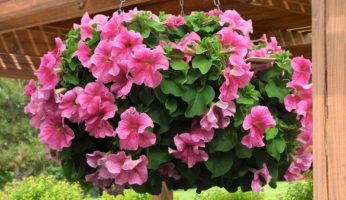

Espresso Frappe - low petunia, up to 25 cm, flowers with fringed petals, 10 cm in diameter, pink, lilac.
Prague is a lush plant, up to 40 cm in height, flowers 8-11 cm in diameter, scarlet, white, pale lilac, white-red, lilac.
Crop care
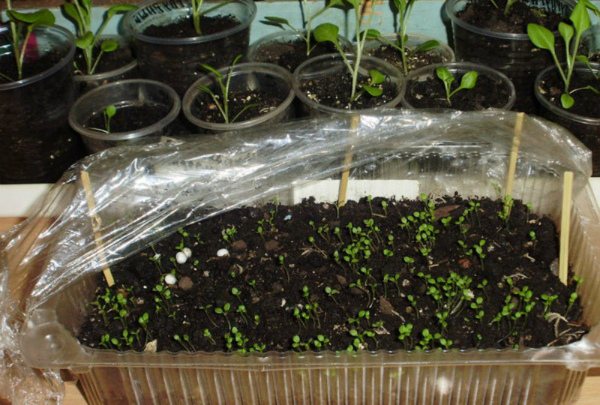

So that the seedlings do not die, it is necessary to monitor and care for it from the first days.
Lighting
Petunia is very light-requiring. She needs a lot of light. After the shoots appear, you need to provide good lighting. Ideally, this is 24 hours a day. But 14-16 hours will be enough, although it will develop a little slower than with round-the-clock lighting. Lighting is especially important for plants planted during the winter months. At this time, the lighting should be at least 19-20 hours.
Watering
While the seedlings are covered, there is no need to water them. But as the seedlings grow, the soil will dry out and here you need to carefully monitor the humidity. Because at this time it is very easy to make such a mistake when the sprouts dry up.Unlike adult seedlings, it will not be possible to reanimate them.
Waterlogging is also highly undesirable. Black leg disease may occur. At first, watering is best done with a medical syringe directly into the soil, so as not to damage the delicate leaves. When the seedlings grow up, they can be watered from a spray bottle with small holes.
Picking petunias
When there are 4-6 leaves on the seedlings of petunia, it must be cut open. That is, transplant into separate cups or into a larger container. She has a very developed root system and this is done so that the roots do not get confused and to get more nutrients.
In fact, picking is the process of removing some of the roots of a plant for better growth of the root system.
In cases with petunias, it is advisable not to disturb the root system at all, that is, to plant it together with a lump of earth. In this case, the rooting process of the plant will accelerate, and it will be less painful.
Petunias can be grown without picking at all, but in this case, you first need to plant the seeds in a separate glass.
Important! When planting petunias in a separate container, fill it ½ the volume. In the process of seedling growth, it will be necessary to add earth.
Then, when planting in open ground, the seedlings are simply transferred together with a lump of earth into the prepared hole. Thus, the roots will not be damaged at all.
Pinching petunias
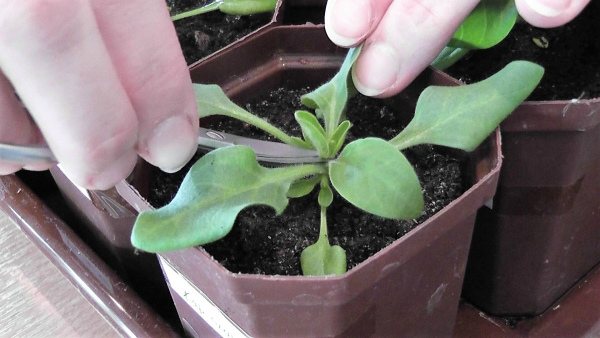

After picking and successful rooting, the seedlings should be pinched. That is, remove the top of the plant. This is done so that the plant grows lateral shoots, and does not stretch in length. Pinch off the top leaves.
The cut should be as close to the remaining pair of leaves as possible. The plucked off part of the plant can be rooted. You just need to plant it in a nutritious soil.
After pinching, it is advisable to immediately fertilize the petunia with complex fertilizer.
There is an opinion that it is not necessary to pinch new varieties of hybrids, but if they grew with a lack of lighting or in cramped conditions, they will stretch, in such cases you will still have to pinch the sprouts.
After the plant is planted in a permanent place, it must also be periodically subjected to the pinching procedure. For a more beautiful bush, for a more lush flowering.
What varieties of petunias are best?
The fragrant beauty has the following varieties:
- bush;
- ampelous;
- cascading;
- calibrachoa;
- floribunda.
Also, plants differ in the shape of flowers. They are fully terry and with a terry edge, large, small and miniature, monochromatic, two-color and fancy. At the same time, which varieties of petunias are better, it is impossible to answer unequivocally. Each grower chooses according to his taste
Bush petunias
Quite a lot of varieties belong to the species:
- milliflora - a popular species with miniature flowers 2-4 cm in circumference;
- multiflora - undersized petunia, varieties of which have small flowers 5-7 cm in diameter;
- grandiflora is an extensive species combining plants with large gramophones.
The Milliflora series are characterized by their compactness and withstand prolonged precipitation. The bushes are planted with small touching flowers.
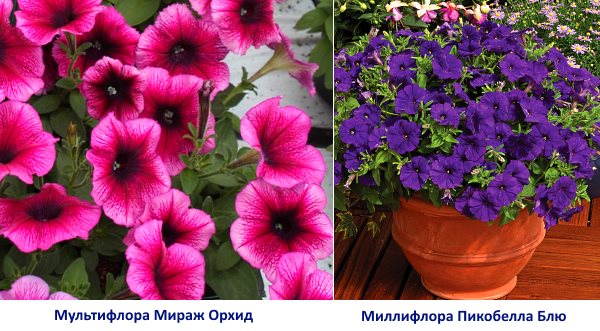

Grandiflora brings together the most beautiful varieties of petunias. The flowers reach a diameter of 16 cm. The variety Frillytunia deserves attention. The bright color is complemented by an interesting corrugated petal edge. The Fimbriata variety also has an exquisite fringed edge, while the Superbissima class, in addition to the wavy edge, sets off a wide throat.
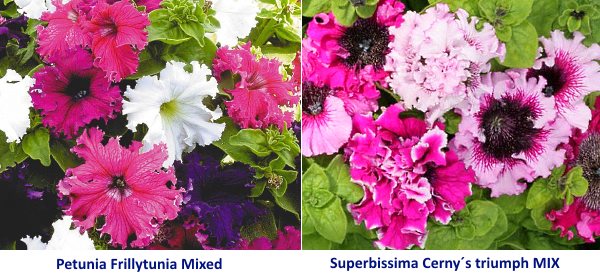

Other varieties of large-flowered petunias are also adorable. In the front gardens, hybrids of the undersized Dreams series occupy a worthy place. They have a wide range of colors. Also known among specialists are small Ultra, Titan bushes. Polaris hybrids bloom before everyone else in the spring. Wind and rain resistant plants of the Storm group.
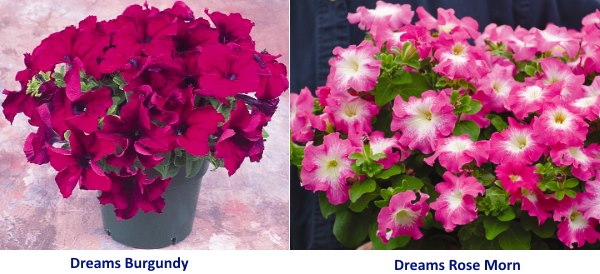

It is not difficult to care for the bush species, since they are mostly formed independently.But you can correct the appearance, achieving greater spreading and splendor of the plant, cut off the top above the internode. You can also pinch the edges of young shoots. From a new point of growth, young sprouts will begin to branch out, on which buds will soon appear.
Cascading petunias
To create floral decor on the loggia, in the gazebo, on the balcony, cascading varieties of petunias are best suited. This species is capable of growing rather large shoots that hang down beautifully and tend up and to the sides. The overgrown bush takes up a lot of space, representing a picturesque thicket.
The most common series of this species are Cherry, Ramblin, Typhoon and Rose. Even in a temperate and temperate continental climate, this series pleases with an abundance of flowers on cascading lashes.
Ampel petunias
Plants of this species form downward shoots. With their help, gardeners can create decorative curtains, cascading waterfalls and other bizarre shapes. They look very colorful in pots of petunias, the ampelous varieties of which are combined with each other, for example, plain and star-shaped. These plants are sometimes used to decorate low-growing trees, floristic forms, gazebos.
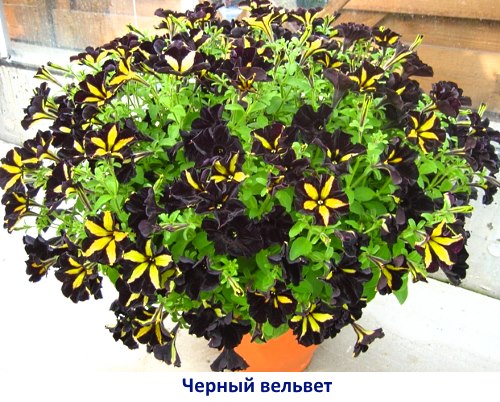

Usually ampelous species are planted in boxes, pots or containers. But the option of planting in the ground is possible. In this case, they cover a decent area, covering the bald spots in the flower bed. Alpine slides, decorated with them, or the shore of an artificial reservoir acquire a truly fabulous look.
If it is possible to create warm comfortable conditions for flowers, they will bloom profusely from spring to autumn. Fertilizers have a very good effect on the growth and color of fertilizers, which are applied no more than twice a month.
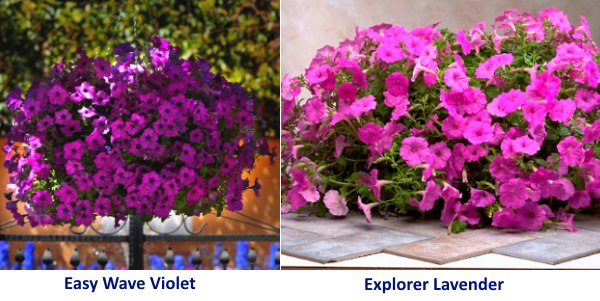

Among petunias, the best varieties are Surfinia. This subspecies of ampelous flowers received the highest marks of flower growers for flowering in the forefront, a huge number of colors, accelerated vegetation, and resistance to bad weather conditions.
It is worth highlighting the following series:
- Light wave;
- Waterfall;
- Pearl and Lilac surf.
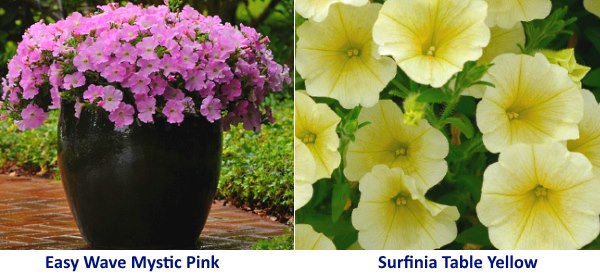

New varieties of petunias
Recently, breeders have been doing a lot of work to breed plants that are resistant to rainy or sultry weather and wind. A lot of effort has gone into producing vibrant exotic colors. Scientists are using genetic engineering expertise to create bright yellow, deep orange, bi-colored plant types.
Black Velvet is a completely new variety of petunia grandiflora, recently bred by British botanists. Large bells are not painted in dark purple or maroon, but in black. It's amazing.
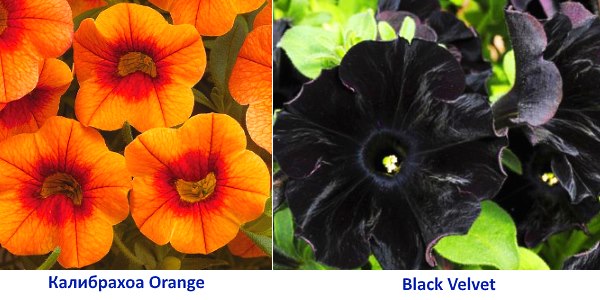

The new variety Table Yellow is one of the most popular ampelous Surfinia petunias. The beauty of the unusual lemon flowers with bright yellow veins attracts attention. The variety is distinguished by its small bud size and goes well with other ampels.
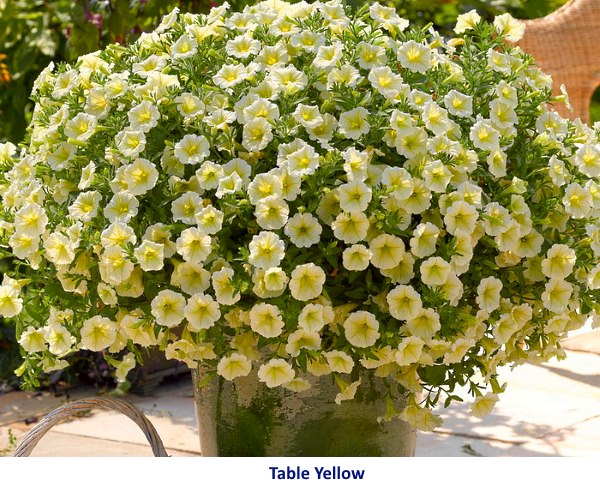

Terry varieties of petunias with a photo
New varieties of petunias are also among the terry hybrids. They are replenished with modern copies almost every year. These varieties are found in different species: grandiflora, milliflora, multiflora. They can also be ampelous and cascading. Terry inflorescences are a little more demanding in terms of care and attention than other types. Heavy flowers cannot withstand gusts of wind, so the most protected place is selected for planting.
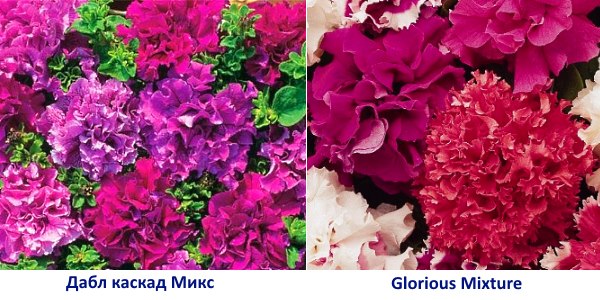

Among the many options for floristic design, the most common are: decoration of a border, front garden, planting a balcony in a box, decorating an alpine slide, planting in pots. And petunias, new varieties of which are becoming brighter and more luxuriant every year, are present in almost all varieties. Do not be afraid to start breeding it and the results will please you.
Video: petunias - varieties and care
«>
Different ways of growing
In addition to growing seedlings in the ground, there are other, less common methods of growing petunias.
In peat tablets
Many gardeners like to grow petunia seedlings in peat tablets.They are pressed peat in the form of small round washers. Various mineral components and microorganisms are added to them to stimulate the root system and good growth of the seedling. The washers are covered with a special dense mesh on top.
When water is absorbed, the peat swells, and this mesh will prevent the tablet from disintegrating. Excess moisture and air necessary for aeration of plant roots perfectly pass through it. The net is impregnated with a special substance, and neither harmful microorganisms nor pathogenic fungi get to the roots of the plant.
The time of planting petunia seeds in peat tablets does not differ from planting in the ground. Also from mid-February to March. Best suited for planting petunias are tablets with a diameter of 3.5 to 4.5 cm.
Before use, the tablets must be soaked in warm water for 5-10 minutes. Then put no more than one or two seeds in each washer, and water it lightly. As well as in the ground, the seeds should not be buried, otherwise it will be difficult for them to break through.
After inoculation, the tablet washers should be placed in a warm, well-lit place. The air temperature should be at least 20-25 ° C. Constantly monitor the moisture content of the tablets and moisturize if necessary. With proper care, the first shoots will appear in 7-10 days.
You can put seed tablets in mini greenhouses. It is necessary to take care of such greenhouses, as well as in the case when the seeds are planted in the ground - to ventilate, moisten.
Watering can be done in different ways:
- Pour water into the pallet;
- Spray the tablets themselves from a small-hole spray bottle.
After the seedlings germinate, when their root system has little space in the tablet, it is necessary to remove the mesh from it and place them together with the tablet in a container with nutrient soil.
If larger tablets were used for growing seedlings, then when planting in a permanent place, it is necessary to remove the mesh from the washer and plant a seedling together with a peat ball in the prepared hole.
Growing petunias in peat tablets - video
In pots, in pots
In pots and pots, ampelous and cascading types of petunias are most often grown. Often novice flower growers think about how much petunias should be planted in one pot or planter? Experienced gardeners say. That in one pot you can plant up to five plants.
For the role of pots, the following are perfect:
- Clay and ceramic pots;
- Plastic pots and pots;
- Mayonnaise buckets and other suitable containers.
It should be borne in mind that no more than one plant should be planted in small containers. Make sure that there is a drainage hole to drain off excess water. It is convenient to put a layer of moss or foam rubber on the bottom.
The containers must be filled with a nutritious soil mixture consisting of:
- One piece of sod land;
- Two pieces of leafy land;
- One piece of peat;
- One piece of humus;
- A little perlite.
Plant petunia seedlings, but do not immediately take it out into the street. It is necessary to gradually harden the plantings, taking out the pots for several hours a day in warm weather, gradually increasing the time.
After the plants have been identified in place, you need to constantly monitor them. Water, loosen, form a bush, remove faded flowers and seeds.
Petunia is a perennial or annual plant
Before introducing you to the best varieties of petunias, I would like to note that in nature the plant grows in tropical countries, therefore it is perennial. In the culture, petunias are grown as annuals, because they cannot stand our harsh winters.
Attention! You can dig a bush in the fall after flowering, transplant it into a pot, cut off the stems and keep it in a cool room until February. Watering the plant at this time should be very rare, keeping the soil slightly moist so that the roots do not dry out. In February, the pot is placed on the lightest windowsill and the flower is watered as usual. Regrown shoots with 4-6 leaves are cut and rooted.By the time of planting in the ground, you will have already grown a rather large bush, and you will not need to bother with sowing seeds.
Reproduction of petunias by cuttings
Beautiful hybrid varieties of petunias, reproduced only by cuttings. To propagate a plant you like, it is important to know the rules for growing seedlings from cuttings.
- In March or April, when it is best to carry out cuttings, the ends of young shoots with 2 or 3 internodes are cut off. The stalk should be 5 or 6 cm long.
- At the cut off shoot, the lower leaves are removed and planted, deepening 2 or 3 cm into a box with prepared soil.
- The land should be light - 50% peat, 25% sand and 25% fertile sod land. It is advisable to pour 1 cm of dry sand on top. The end of the cutting is dipped into Kornevin before planting.
- Water the cuttings with clean water with a weak solution of potassium permanganate.
- After 2 weeks, the cuttings will take root and then they need to be planted in separate containers.
Petunia flowers will decorate the front garden, loggia or flower bed with abundant flowering. Many varieties bloom all summer long and smell pleasantly. You can choose any color of flowers to create a beautiful garden or room decor.
Content
- Listen to the article
- Description
- Growing petunias from seeds Sowing
- Seedling care
- When to plant
- How to care
- Multiflorous petunias (multiflora)
Reproduction and planting
Consider how a plant reproduces, how to properly grow and plant seedlings.
Sowing dates for seedlings
Sowing dates vary slightly from region to region. Seeds of bush petunia are sown in boxes or sowing containers no earlier than mid-end of February (in the Moscow region, Moscow, Central Russia), then at the end of April-beginning of May, seedlings can be planted in soil or pots. Ampel varieties develop longer, so they can be sown on February 10-20.
Sowing too early often fails, even with backlighting. If sown in January, then by the end of April the seedlings will grow strongly, begin to bloom, the roots will be cramped, transplanting becomes difficult - the roots are intertwined. It is necessary to dive plants in time into seedling boxes, and then into separate pots.
Location requirements
Petunias and surfinias love the sun, which is due to their South American genetic makeup. These are heat-loving and sun-loving plants, therefore, it is necessary to provide for a completely sunny position for them, otherwise they will stretch out, fade, and give much fewer flowers. It is ideal to grow petunias in places with a southern or southwestern exposure. On the balcony and flowerbed, it is worth taking care of protection from the wind that can damage the flowers.
Requirements for pots for petunias:
- a hole for the outflow of water is required;
- the pots must be deep enough to accommodate the functional drainage layer (expanded clay).
Features of planting in pots
Photo. Boxes 80 cm wide were used on the balcony. 7-8 seedlings were planted in each. There are many flowers, but they do not completely cover the white box.
For comparison (after a year) the same boxes, in which there are only 4 seedlings left. This is tangible proof that more is not always better. The flowers grew incredibly because there was room and opportunity to grow.
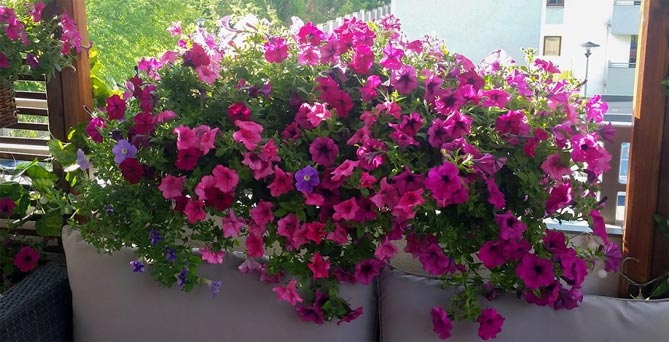

If possible, plants with the largest flowers and longest shoots should not be planted in places subject to rain or wind gusts. Bushes look less attractive after rain, and ugly spots appear on flowers of more delicate varieties.
Soil requirements
An ideal petunia soil should have the following characteristics:
- easy,
- permeable,
- fertile,
- humic,
- slightly acidic pH: 5-6.5.
The best soil for petunias is a humus substrate with the addition of sand.Sand is needed in the soil mix because the roots of the plant need a lot of air.
Surfinia are more capricious, it is better to buy a special substrate for petunias in garden stores, which provides plants with ideal conditions for development. In our climate, cultivation prevails in flower beds, in containers, boxes with soil.
Seed propagation
To have your own petunia bushes, you need to buy spring seedlings or try to prepare them yourself, which is a little more difficult.
Need to know! Cascading varieties are propagated mainly from cuttings in specialized farms. This method in amateur cultivation is not only difficult, but also fraught with the risk of contamination of seedlings with disease-causing pathogens, including viruses.
Seeds for sowing are harvested in the fall from dried, undamaged inflorescences.
Growing petunia seedlings from seeds includes the following steps:
- Sowing seeds for seedlings is carried out in late February-early March in moist soil, consisting of deoxidized peat and sand. The seeds are placed in the ground, sprinkled with soil and compacted with palms. The container is placed in a sunny place and the ground is irrigated regularly. Germinate the culture at a temperature of 20 degrees. Plants usually germinate within 1-1.5 weeks.
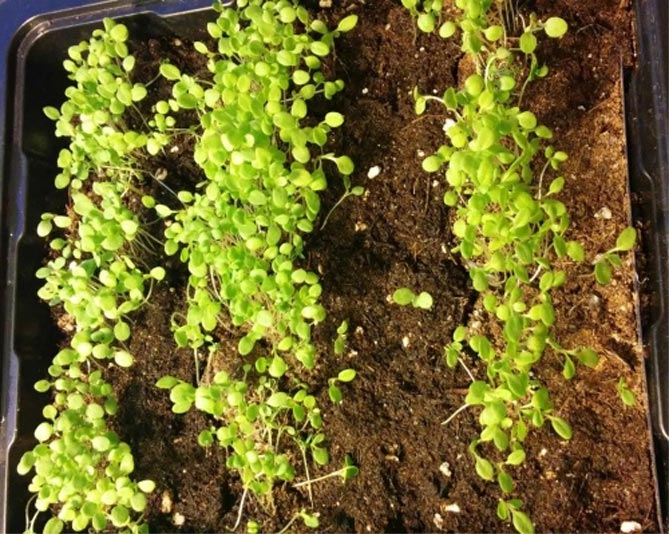

- When 2-3 leaves appear (about 2-3 weeks after germination), the seedlings are transplanted into small containers, at a distance of about 3 cm. The containers are placed in a sunny, warm place.
- When daytime temperatures are around 10-15 ° C, you can plant your seedlings outside. You can leave flowers on the balcony for a long time at the end of May. The plants are then transplanted into large containers.
Attention! Before you start breeding petunias from your own seeds, you need to remember that garden petunias are hybrids, this fact can cause differences between grown plants and maternal ones. Plants grown from ready-made seeds will give you much more confidence in appearance.
Transplanting
Planting petunia seedlings (purchased or grown independently) is carried out when the probability of return frosts passes (usually the end of May). When planting, leave a distance of about 30 cm between individual seedlings. Flowers are very sensitive to frost, early planting can threaten the plant from freezing.
Petunia ampelous
The simplest, unpretentious, the most widespread variety in Russia. This type is distinguished by hanging flowers, delicately pink shades, such a petunia looks beautiful in a bowl, on a lawn.
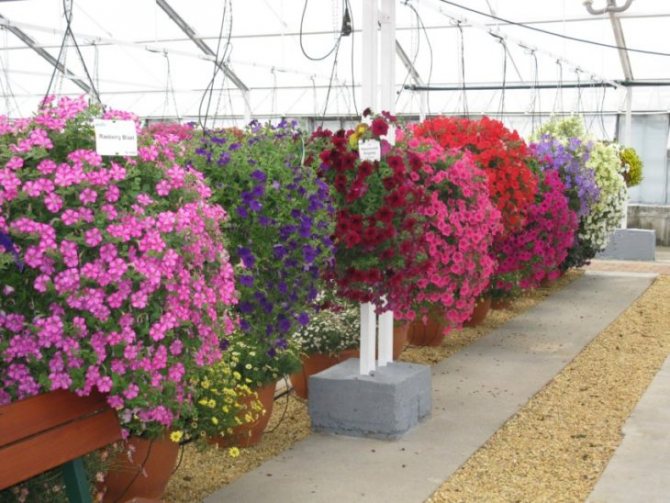

Ampel petunia curls so that the ground is completely invisible, only a thick, colored carpet is formed.
Bush variety of petunias
The largest group of plants. Has gained great popularity among florists due to its many shades. Bush petunia is represented by low-growing and tall varieties. The diameter of the flowers ranges from 5 cm to 16 cm. The plant can be grown both in the open field and in containers, vases.
This type is undemanding to care for. Bush petunias form a crown on their own, do not need pruning. The only thing that can be done is to pinch the tops of the shoots. This will make the bush more lush by activating the side lashes.
Ultra (Ultra)
Hybrid petunias that are compact in size. There are many varieties presented in this series, the most famous of them are: Plum, White, Raspberry, Pink and Blue Star. The main features of the species:
- bush up to 35 cm high and no more than 40 cm wide;
- the diameter of the flowers is about 9 cm;
- violet, red, pink, white, blue, burgundy shades are possible.
Petunia is not afraid of temperature extremes, minor frosts. Tolerates rainy weather. Thanks to this, she feels great outdoors, serves as a decoration for flower beds.
Daddy
Very effective bush petunia, presented in several shades. The main characteristics of the variety:
- compact bush, up to 40 cm in height;
- the diameter of the flowers is about 12 cm;
- common colors are white, blue, red, bright pink.
Daddy is not afraid of drought or rain. Shows resistance to wind. The bushes are not branched, therefore, to create luxurious bouquets, it is advisable to plant seedlings close to each other. They thrive best in containers.
Polaris
A relatively new variety that attracts attention with contrasting colors. The main features of plants:
- the height of the bush is about 30 cm;
- shoots are completely covered with medium-sized flowers;
- two-tone color - a combination of bright shades with wide longitudinal white stripes.
Flowers are not only beautiful, but also unpretentious. They endure drought, cold snap, rain, strong winds. They are characterized by fast growth. Early flowering variety.
Seed selection
Petunia seeds are sold in two forms:
- in granules;
- in bulk.
Seeds in granules are more convenient, they have good germination. It is worth deciding on the timing of sowing them for seedlings.
It should be remembered that two months pass between sowing and the first flowers. They begin to plant seedlings from the second half of February, until the very middle of March. It depends on whether it is possible to provide the seedlings with additional illumination, since there is still insufficient daylight in February.
For seedlings of petunias, a neutral or slightly acidic soil is needed. It should be a nutrient mixture that is loose and that retains moisture without getting wet. You can purchase the mixture at the store. Universal ready-made substrate Stender. For 5 liters of the Stender, you should also put half a liter of ash, a large spoonful of potassium sulfate, 250 grams of perlite and mix well.
Another variant of the mixture: part of the garden land, part of the sand and two parts of peat. Stir, sift through two sieves of different sizes and pour over with a strong manganese solution. Or use Previkura solution.
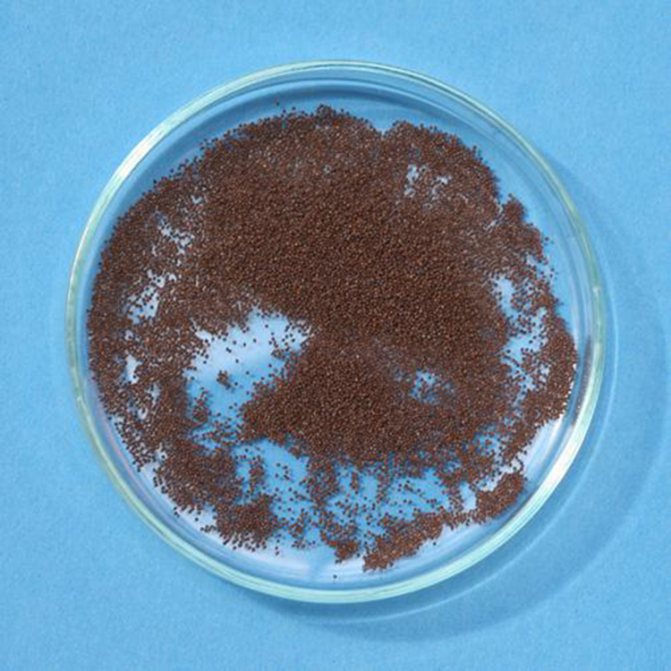

At the bottom of the container, drainage is poured, then the earthen mixture with a layer of 6 cm. There should still be at least 3 cm to the end of the sides. The seeds of petunia are very small, it is difficult to sow them. Granular seeds are more convenient. They can be taken with tweezers and placed on the ground in rows.
The seeds are not deepened, they are simply sprinkled with a two millimeter thin layer of soil. If loose small seeds are used, then they can be sown in three ways:
- use of sand;
- use of snow;
- with a toothpick.
The first method is that the seeds are mixed with sand and distributed over the substrate, previously watered with water. From above, the crops are slightly moistened using a spray bottle, and sprinkled with a millimeter of soil. You cannot use a watering can, as such watering will greatly deepen the seeds into the soil.
The second method involves sowing petunia seeds on a thin layer of snow, laid in a 1 mm layer on the surface of the substrate. Seeds are poured onto the snow and distributed over the entire surface with tweezers. When the snow melts, it pulls in the seed to the desired depth and moisturizes the crops. And you don't need to water or sprinkle it with earth.
The third method of sowing is with two toothpicks. The seeds are poured onto a white sheet of paper. Pick up the seed with one toothpick, with a tip moistened with water, and shake off the other with a toothpick, moisten it on top and sprinkle it with a substrate.
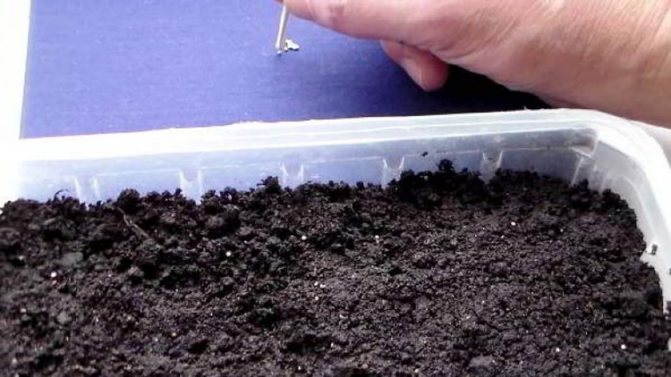

Having finished sowing, the containers are closed with transparent material and taken to a warm room, where there is enough light. With a temperature of 25 degrees.
The seeds can be planted in special seedling trays. You can choose by the number of cells. A cassette with cells is useful for repeated use, and seedlings in them do not need a pick. Experts advise to choose sufficiently spacious cells with a height of 10 cm.
The cells are filled with the substrate. The care for the seedlings in the cassettes is the same as for the seedlings in the regular boxes. Some growers plant seeds in special peat tablets. It is easiest to plant pelleted seeds in them. We need peat tablets 4.5 cm in diameter. They are put in water to get wet. Then the excess liquid is removed, and the tablets are placed in a container with high edges.
You can use cassettes. One seed is placed in each tablet, poured with a pipette to soak the seed shell. When the shell is wet, you should smear it with your fingers so that the seed germinates faster. The landings are covered with a transparent material.
It is believed that it is easier to care for such seedlings, it does not need to be replanted and it is easy to understand when it needs watering. In addition, with this method, the germination of petunia seeds is much higher.
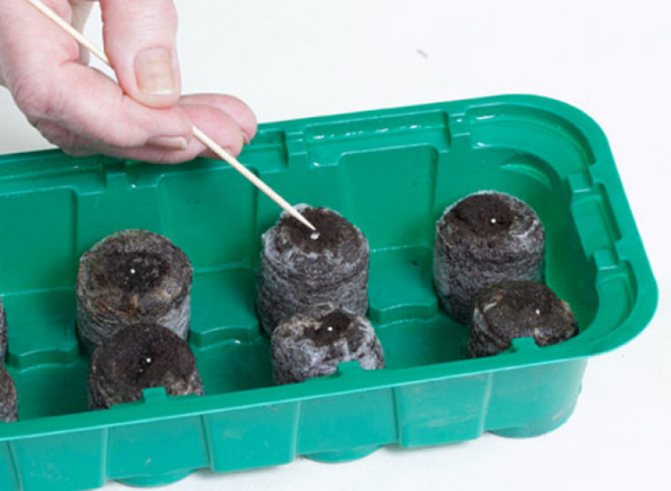

Preparing seeds for planting
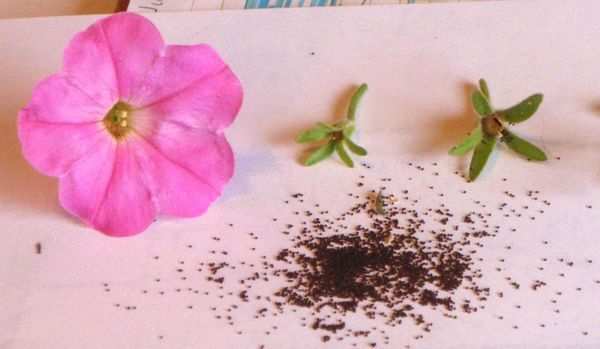

To successfully conduct a seed campaign, you need to do the following:
- study the instructions for sowing petunias for seedlings at home;
- prepare a soil for planting that meets all the requirements;
- select suitable containers for planting;
- choose a rooting method - in pots, in cassettes or in tablets.
The correct planting of petunias for seedlings involves taking into account all the nuances and timely completion of all the work indicated above.
Petunia seeds differ from seeds of other flowers in a number of ways. The seeds are very small - only 0.2 to 0.5 mm in diameter. It is clear that it is not easy to pick up such seeds, let alone sow them.
To simplify sowing, you can buy pelleted seeds, enclosed in a special shell.
The shell that covers these seeds is made up of nutrients that promote the rapid germination and development of the sprouts.
Important! Granular seeds require constant moisture in the soil so that the shell is soaked and the seedling can break through.
Important points:
- Petunias require special containers and special soil.
- Barely appeared seedlings need high-quality illumination.
- Petunia also places high demands on the level of soil fertility, so top dressing will definitely be needed.
The best orange petunias: varieties and hybrids
Orange petunias have only appeared on the market in recent years. In 2014, the Japanese company introduced a hybrid called the African Sunset. It was not possible to obtain an orange color in petunias using traditional breeding methods, and then one of the companies resorted to trick, launching on sale transgenic orange petunia, bred for scientific purposes, without GMO labeling.
But at present, this variety is banned for sale in Europe, the USA and Australia, and you can only buy the remains of old supplies from us.
Other varieties of salmon colored petunias that can be found commercially:
- Eagle Salmon;
- Picobella Salmon;
- Duvet Salmon;
- Ez Rider Deep Salmon;
- Ramblin Peach Glo;
- Easy Wave Coral Reef;
- Amore Mio Orange.
Orange and salmon petunias look great in container compositions in the garden and on the balcony in combination with annuals of yellow or purple colors.
Multiflora
Multiflora is a multi-flowered petunia. Varietal varieties and hybrids of multi-flowered petunias are distinguished by an abundance of medium-sized flowers. These plants are resistant to any adverse weather conditions. Singles are visually similar to flower balls, and in flower beds they resemble a solid floral carpet.
Among the multi-flowered varieties, the following should be distinguished:
Merlin - This is a perennial multi-flowered petunia, but is grown as an annual. The variety is easy to grow. The culture prefers the sun, easily tolerates light frosts, droughts and rains. There are about 17 bud colors. There are not only monochromatic flowers. There are also veins and a border of a different color. This compact petunia with small but numerous flowers is ideal for landscaping verandas and flower beds. It is considered undersized, since the height does not exceed 25 cm.
Merlin blue morn
Mambo - undersized annual petunia belonging to the group of multiflora (multiflora). This is a very popular culture in floriculture. The color of the buds is varied. Mambo pleases the whole season with its abundant flowering.
It is used to decorate flower beds, a variety of compositions, and can also be grown at home. It goes well with other flowers: marigolds, coleus, begonia and others.
Mambo red and Mambo Purple
1. Seven Secrets of Success:
| 1. Growing temperature: during the growing season, they contain petunias at a temperature of 18 to 25 ° C, in winter it is advisable to place it in a cool place with a temperature of about 13 - 15 ° C. |
| 2. Lighting: brightly lit location shaded from direct sunlight during spring and summer during daylight hours. Plants can sunbathe for 4 hours daily for flowering. When grown in partial shade, flowering will be less abundant. |
| 3. Watering and humidity: well-separated water at room temperature, in spring and summer, water the petunia abundantly, drying the upper layer of the substrate between waterings, in winter they simply protect the soil from completely drying out, greatly reducing the frequency of watering, it is desirable to increase the air humidity. |
| 4. Pruning: Regular pinching of young shoots, forming pruning after flowering, timely removal of wilting flowers to form new buds. |
| 5. Priming: neutral or slightly acidic soil, nutritious and well-drained soil with a loose structure. |
| 6. Top dressing: feed the petunia with phosphorus - potassium or organic fertilizers during the spring and summer every 2 weeks. In winter, at low temperatures, feeding is not carried out. |
| 7. Reproduction: sowing seeds in late winter or spring, stem cuttings in spring and summer. |
Botanical name: Petunia.
Domestic petunia - family... Solanaceae.
Origin... The birthplace of petunia is South America.
The best yellow petunias: varieties and hybrids
More than 20 years after the red one, the first yellow petunia was obtained by breeders. In 1977, a new hybrid with yellow flowers was launched by the American company Goldsmith Seeds and was named Summer Sun.
But breeding work to improve the new shade continued, and in 1998 a new yellow-flowered petunia, Prism Sunshine, was introduced, which won the prestigious Fleuroselect breeding awards and the American Award as "the brightest, most lush and abundant flowering".
This cultivar was seen as a breakthrough, as earlier varieties of yellow petunias had sparse bushes with a modest bloom of pale yellow flowers. But today there is also a brighter yellow petunia hybrid Lavina Yellow Star with a cascading bush shape.
Nevertheless, the same rich yellow tone as, say, marigolds and sunflowers, is not yet found in petunias. Usually, yellow petunias do not grow as bright as they are shown in advertising pictures.
Among the ampel petunias, there are also specimens blooming with yellow flowers. The previously popular Baby Duck Yellow petunia disappeared from sale for unknown reasons, but Easy Wave Yellow, very similar to it, appeared in the Easy Wave ampel series with numerous medium-sized pale yellow flowers and a cascading bush shape.
The original yellow-green color is distinguished by large-flowered bush hybrids Debonair Lime Green and Sophistica Lime Green. The latter cultivar also has an incredibly interesting variation of Sophistica Lime Bicolor, which opens up huge flowers in which yellow-green is oddly combined with raspberry.
I would also like to draw the attention of flower growers to another hybrid with the presence of the yellow color "Kupala Ingrid", the seeds of which, for some reason, are much cheaper than many other hybrids. And the color of the flower is very unusual. In the center of the beige inflorescences there is a reticular pattern that changes color, which can be yellow, brown and even pinkish, but from a distance such flowers look almost yellow.
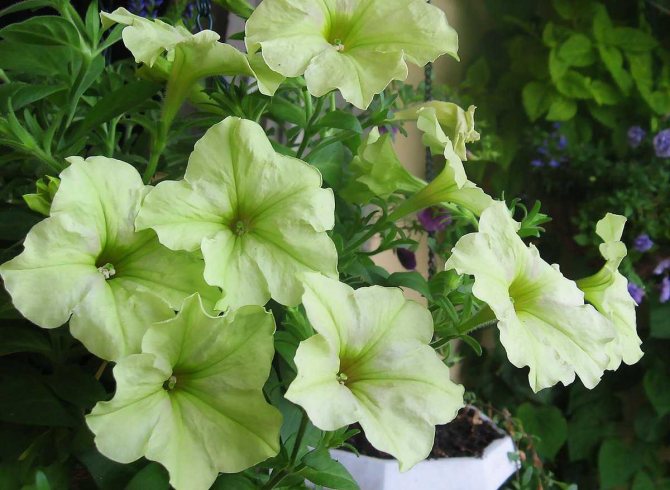

Yellow petunia Sophistica Lime Green.
The largest
The largest flowers are possessed by plants of the grandiflora group.
Triumph - This is a variety of petunias grandiflora.Terry flowers are very large, up to 16 cm in diameter. They grow up to 60 cm. Triumph is grown in a variety of flower beds, on balconies.
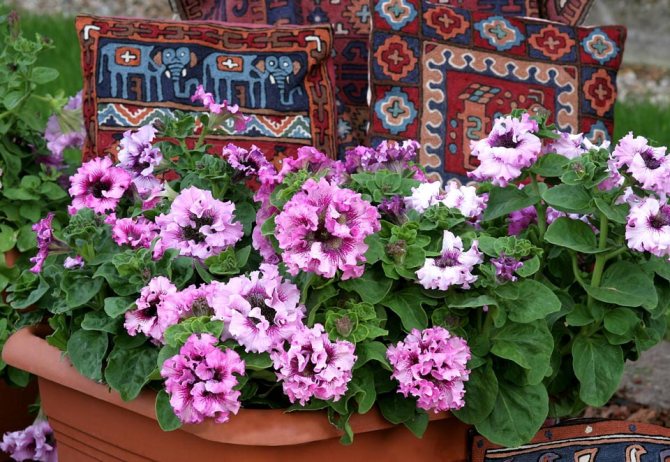

Triumph from Aelita.
Large varieties should also include Limbo... The diameter of its flowers can reach 12 cm. The culture itself is undersized. This variety is resistant to bad weather. Grown in flower beds, containers, balconies.
Petunia series Limbo
Variety Prism also applies to large plants. The flowers have a diameter of 8-10 cm. This is a compact and undersized culture. Very early flowering. The colors are different. Prism is grown in flower beds, rabatki.
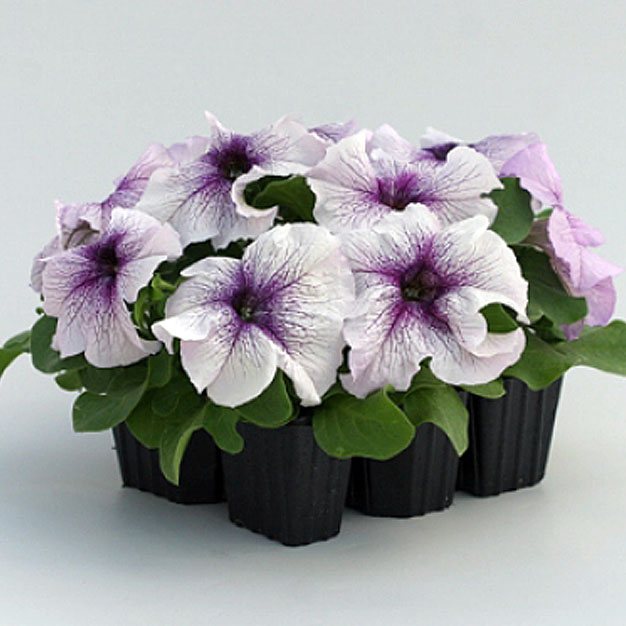

Petunia from Prism series, color Blackberry Sundae.
Unpretentious varieties
Petunia is an unpretentious garden culture. Most varieties are undemanding to soil. They are not afraid of rain and wind. The only thing that all petunias love is warmth. Therefore, it is advisable to grow a flower in sunny places or in partial shade.
The plant is afraid of frost, so for the winter it is brought into a warm room, home or on the veranda. The culture is perennial, but it is very difficult for it to survive the winter in Russia, therefore it is grown here as an annual. It is also possible to grow a beautiful petunia in Siberia, especially since there are varieties that are resistant to slight frosts, but proper care and selection of varieties are necessary.
Pikobella - very easy to grow variety due to its resistance to bad weather. This varietal variety is more tolerant of all kinds of unfavorable weather conditions than others. However, Picobella cannot stand frost and lack of light. This is a small-flowered culture with numerous small flowers.
The multi-flowered variety Snow Globe will decorate any garden plot or balcony without creating much trouble for the owner. Beautiful white flowers will delight with their abundant flowering until the very frost. This culture is not afraid of rain, wind or drought.
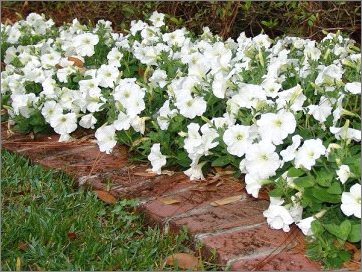

Snowball
Option number 2: "Artist's palette"
Very unusual, not "hackneyed", and most importantly - a simple option.
- To make a flower bed of petunias in the form of a palette, you need to get a piece of plywood or drywall measuring 100x100 cm (approximately).
- We draw on plywood a large palette with circles for paints, in which your petunias will bloom later.
- Now, using a jigsaw or an electric saw, we cut out the desired shape and holes from the material.
- We must open the material with a moisture-repellent agent or cover it with paint (varnish).
- We put the palette on the intended place of the flower bed, where the land has been prepared in advance. It is advisable to make a slight bias.
- We plant petunias of different colors in the holes for paints.
This is how unrepeatable things are easily created!
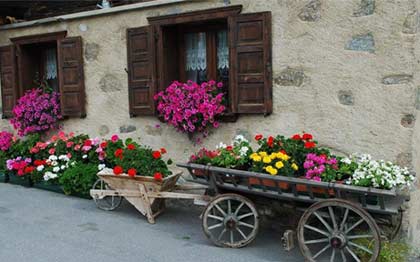

This type of flower bed is easy to make: you need a decorative cart and containers for planting petunias and pelargoniums
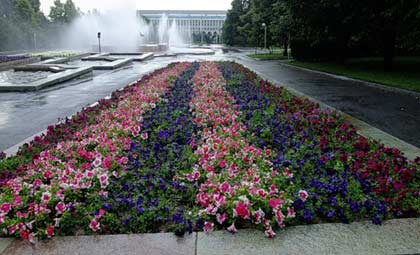

Want a pretty quick petunia flower bed? Then just plant different varieties in even rows one after another.
Cascading variety of petunias
Cascading petunias are in many ways similar to ampelous varieties. Their main difference is thicker, slightly shorter shoots. In addition, only adult plants acquire a hanging shape. Young seedlings are mainly vertical.
Cascading petunias do best in hanging pots as they need a lot of space to grow normally. One plant requires up to 5 liters of soil. Used to decorate gazebos, balconies, verandas. An important advantage of the cascading variety is its large flowers.
Gioconda
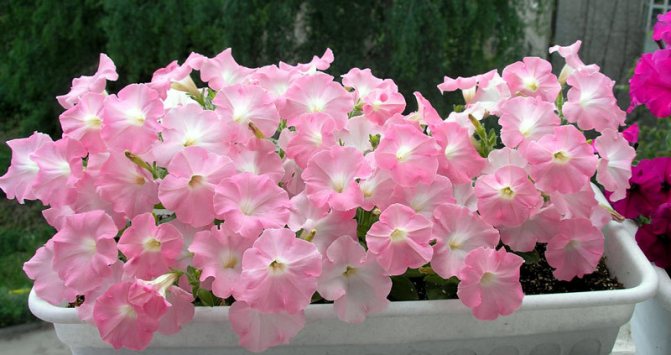

In warm regions, petunias are able to bloom all year round. Even in cold areas, flowers can be preserved by taking them from the street to the house. The main features of the variety:
- the height of the bushes is about 20 cm;
- highly branching shoots, about 1 m long;
- flower diameter up to 6 cm;
- shades - orange, white, salmon, scarlet, purple, violet.
Gioconda is not whimsical to climatic conditions. It survives both in frosts down to -8 ° C and in heat up to +40 ° C.
Ramblin
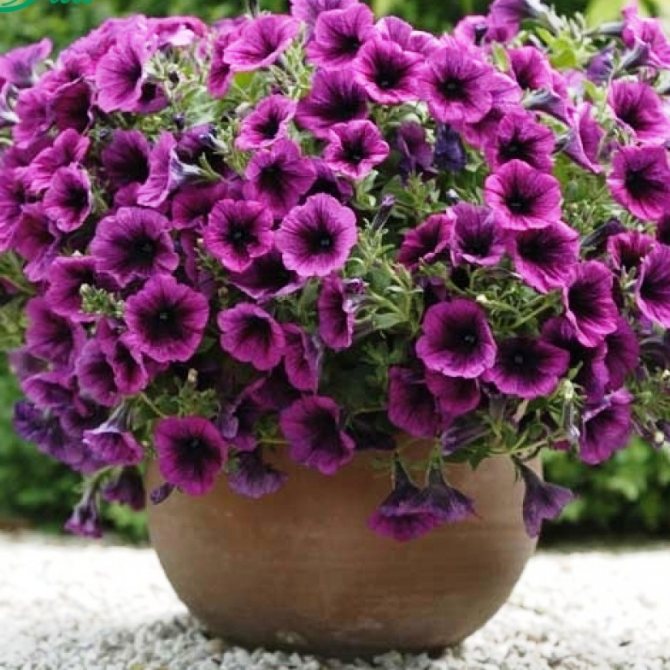

A low-growing variety of petunia. Ramblins are represented by 12 hybrids. Among them there are one-color and two-color varieties. Key Features:
- sprawling bush, no more than 35 cm high;
- lash length from 0.5 to 1 m;
- funnel-shaped flowers, about 8 cm in diameter.
Coloring is presented in all shades of purple, red, pink. There are also pure white buds. Two-color hybrids are represented by a combination of lilac and salmon shades interspersed with white.
Burgundy
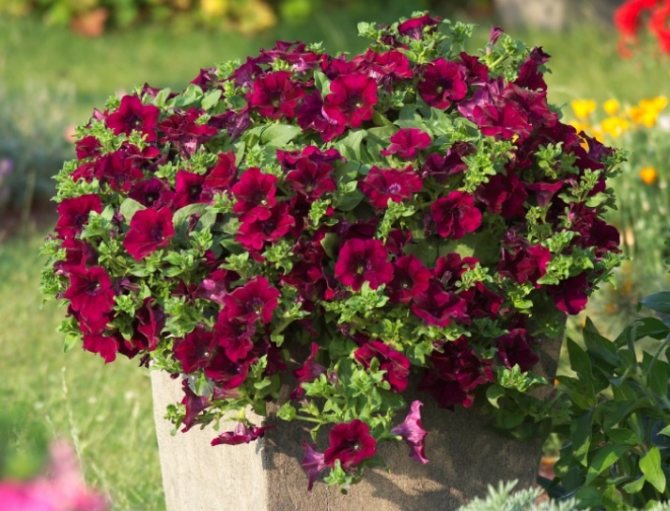

The name of the petunia indicates its color. This is a super-cascading variety, relatively recently bred by breeders. The main features of the hybrid:
- the height of the bush is about 30 cm;
- shoots are flexible, up to 70 cm long;
- flower diameter 5-6 cm;
- flowering period - from May to October.
Petunia is presented in 2 varieties - with dark blue and purple-red color. The bush blooms profusely. The flowers are multilevel, with corrugated edges.
Collecting seeds
If you need petunia seeds for seedling next year, you should select a few lower buds on the bushes of the selected varieties. The process of seed formation in these buds is faster. After 60 days from the formation of buds, the seeds will ripen.
The boxes are cut, the seeds are poured and stored at room temperature. Each box contains about one hundred seeds. They are very small, about half a millimeter. Then for four months the seeds ripen at home. They do not lose germination for about four years.
It is best to distribute the seeds in bags, and sign where which variety, so as not to confuse.
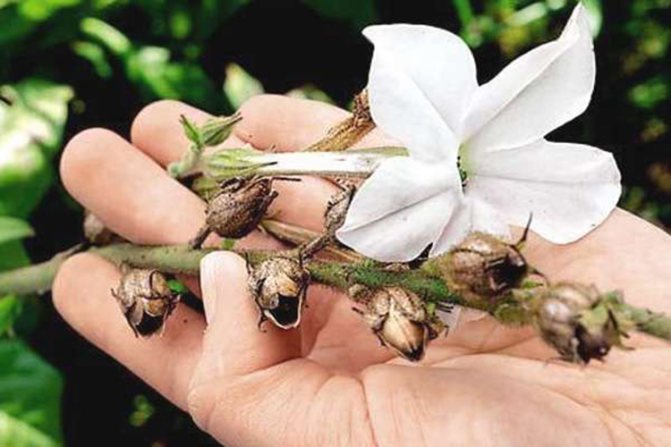

Terry petunias
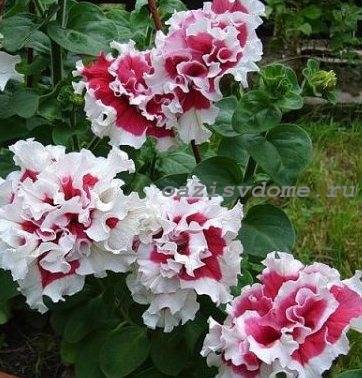

Terry petunia
Branched bushes of terry petunias grow only up to 25-30 cm in height. But they bloom magnificently of extraordinary beauty with double flowers. Flowering begins in early summer and lasts until late autumn. Large double flowers can be either monochromatic or multi-colored. But also plain double flowers are simply mesmerizing with corrugated petals.
Corrugated varieties of petunias are grown in flower beds, flowerpots, balcony boxes, hanging baskets or pots. They are distinguished by their unpretentiousness and lush, long flowering.
Photo of terry petunias
Petunia Pirueht F1 (Pirouette F1)
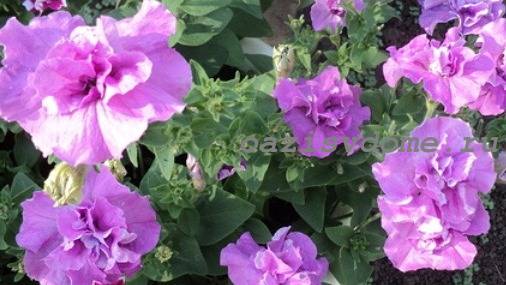

Petunia Duo (Duet) Petunia terry Dabl kaskad (Double cascade) Petunia terry Dabl kaskad burgundi (Double cascade Burgundy)
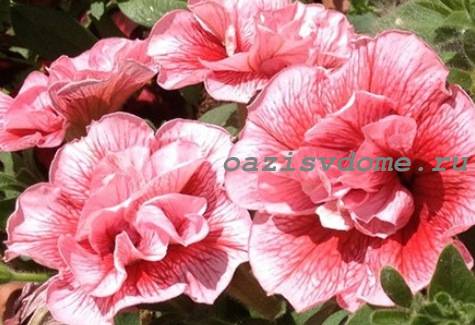

Petunia Angora (Angora) Petunia Pirouette_Purple (Pirouette purple)
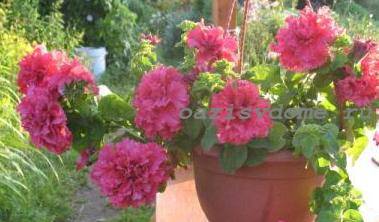

Petunia terry Valentajn (Valentine)
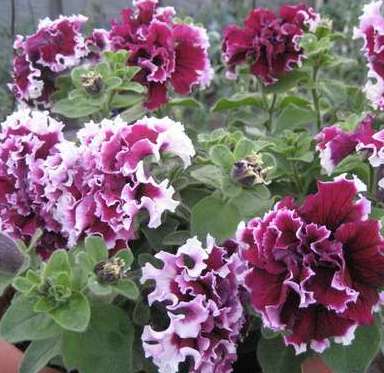

Terry petunia Pirueht (Pirouette) Terry petunia Pirueht rouz (Pirouette Rose)
Growing seedlings of petunias
To get strong and high-quality seedlings, you need to be careful about the choice of containers and soil. Seedling boxes should be made of wood, plastic or ceramic. The containers should be wide and of medium depth. Drainage holes are required. Plastic disposable food containers can be used.
Drainage must be placed on the bottom of the container. You can use expanded clay, pebbles. You can buy a special drain from a flower shop. This is necessary so that the air passes to the roots, and water does not stagnate in the soil.
Then the seedling containers should be disinfected. You can use formalin or potassium permanganate solution. After processing, the container should be thoroughly rinsed with water. If the seedlings are planted in a wooden box, a layer of paper should be laid on the bottom, preferably thick paper.
Petunia: briefly about the flower
The genus petunias belongs to the Solanaceae family. The name of the flower is translated from Brazilian as "tobacco". When the plant was discovered in the 18th century, its leaves were confused with tobacco leaves. The native land of petunias is the forests of South America. Weak stems of the plant branch well. Rod-type roots occur close to the surface of the earth. A feature of the flower is creeping, erect, undersized stems. There are also varieties with high shoots. The shape of the light green leaves of petunia depends on the type of plant.They sit tightly or on petioles on stems covered with delicate hairs.
The ornamental culture is valued for its funnel-shaped flowers with an upward-expanding socket of the petals. The edges of the fused petals are wavy, even, corrugated. The color of the flowers is striking. The predominant is the white, red, blue gamut of the background, on which there can be stripes of contrasting color.
Petunia blooms all summer, delighting with splendor, luxury of shades. In autumn, the fruit is formed in the form of a box with small seeds.
Varieties of yellow petunias in design
Yellow petunias look very cheerful and create a sunny mood in any corner. This shade is one of the easiest to create all kinds of combinations. Yellow hybrids will look best in the company of plants with purple and blue flowers, whether they are purple petunias or any other annuals (lobelia, alissum, ageratum, brachycoma, etc.).
Plants with red flowers (for example, hybrid verbena or pelargonium) in the company with yellow petunia will create a sense of solemnity and will never be left unattended. Pink tones combined with yellow flowers are the key to creating a gentle romantic atmosphere.
Ampelous pink diastia, clouds of pink alyssum Easter Bonnet Peach and other pink and purple annuals are perfectly combined with large flowers of yellow petunias.
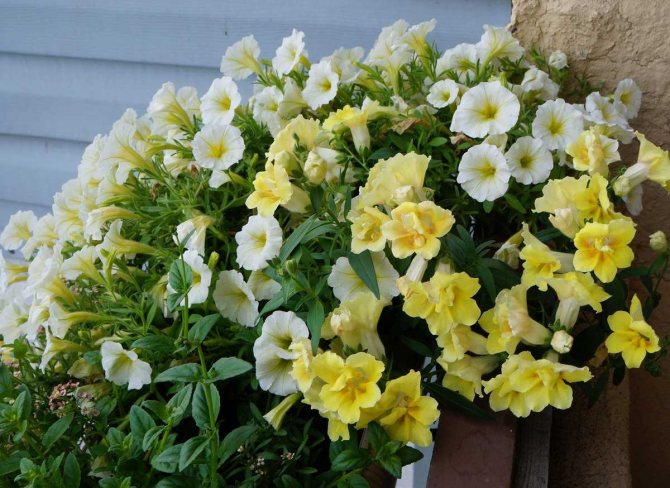

Easy Wave Yellow petunia and snapdragon.
Option number 3: "Blooming cart"
If in your household there is an old cart or cart that you were going to send to the trash, but everyone was sorry - this option is yours!
You will need a lot of space for such a flower bed, so this option is good for large yards. So let's get started:
- In the place of the flower bed, we fill a pile of earth with a height that corresponds to the height of the open edge of the cart.
- We fill the wagon with earth and tilt it to the hill so that it seems as if the earth has spilled out of the cart.
- Now we sow or plant a cart with a slide with different petunia flowers to give the impression of scattered flowers.
The Blossom Cart looks very impressive and lends a rustic touch to the courtyard design. An excellent option for a country estate.
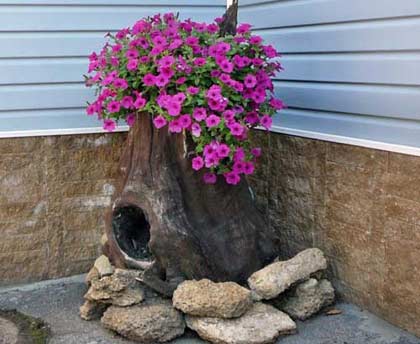

How do you like this option? Old tree stump and some stones, we think it's easy to find
Related article: All about planting and caring for petunia
7.Appointment
Showy decorative flowering plant, which is used in landscaping parks, squares. Ideal for growing on balconies and terraces.
Ampel species very attractive in hanging baskets. A bright beauty - petunia will serve as a decoration for any flower garden or flower bed in the garden, and the long and abundant flowering rightly made it very popular with flower growers.
↑ Up,
Photo of petunia flowers
Blue petunias in garden design
In the best way, petunias of shades of purple are combined with plants that have yellow and orange flowers or foliage. Therefore, from flowering annuals to the "blue" varieties, it would be nice to add undersized snapdragons, tunbergia, nemesia, calibrachoa, etc.
Ornamental foliage with orange and yellow foliage, such as the numerous hybrids of Coleus and Ipomoea sweet potato, will also be a great addition. The addition of white to purple petunias creates austere cold combinations that will have a refreshing effect on a hot summer day. Partners of purple petunias can be both other white petunias and annuals with a scattering of small light flowers.
Petunia - growing and care
Let's start with the soil, the requirements for which for the successful cultivation of petunias are quite classic: fertile soil, with a preference for loam and sandy loam; accepts ripe humus and compost; does not like acidic soils - add lime within the range: 200-300 grams per 1 M2; in the spring, it needs complex fertilizer, which must be applied during the digging of a site for planting petunias. Fresh manure is a disaster for any plant, even more so for petunias - fungal diseases begin.
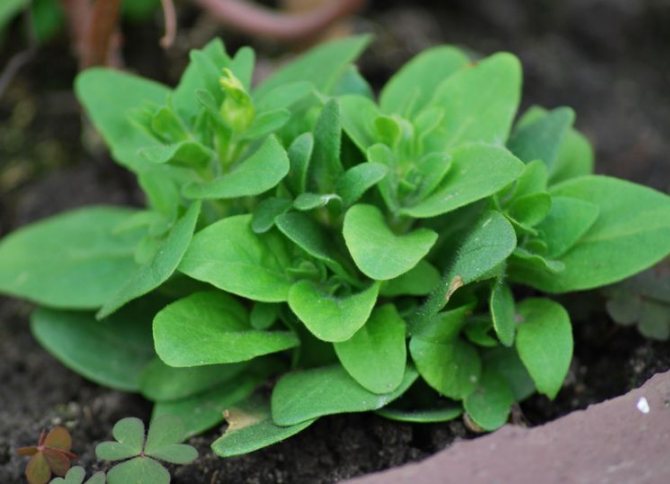

Petunia prefers open areas to be under the sun throughout the day. Then it constantly and densely blooms with compact bushes and juicy stems, and with a lack of light, it stretches out with thin branches, where, nowhere, a flower is a sad sight ...
And although the petunia has a root system very adapted to watering pauses, abundantly branching over a sufficiently large soil space, these pauses should be short-lived. This is a moisture-loving and very grateful plant, capable of self-reproduction with sufficient moisture through seeds that can survive even winter frosts with a snow cover, however, and provided there is sufficient soil moisture.
Petunias are of different types: terry, large-flowered, small-flowered - of the most incredible color. Small-flowered petunia is more hardy and blooms all-season, large-flowered is much more capricious: in a damp and cool season it stops blooming; suffers from heavy rain, which can turn her flowers into a messy mess. Even watered such petunia carefully - at the root, in order to preserve its delicate large flowers.
Petunia is very demanding on feeding. The first of them - after a week of planting its flower seedlings, and then after periods of 7-10 days, feed it with an aqueous solution of complex fertilizer. It is optimal to alternate fertilizing inorganic with organic (infusion of weeds and mullein, for example) Until August, petunia needs additional fertilizing and pays for this with generous flowering.
Ampelny and for pots
Ampel petunias are lovers of heat and sun. In this regard, the plant is more common in warm countries than in Russia.
Ampel petunias are beautiful in the frame of balconies, windows. The shoots of the plant are long and drooping; they grow downward. Loves light and sun, grows quickly and has a very lush flowering. The sizes of the flowers are different. Perfect for planting in pots, vases, including hanging ones.
Ampel varieties
Easy Wave - American variety, is an improved form of the Wave variety. Easy Wave is one of the easiest varieties to grow. The colors of the plant are varied: red, pink, purple, blue, yellow, burgundy. More counts semi-ampel petunia, since they form a spherical or domed crown. Most often, the plant is planted in floor pots, but it is often used in hanging pots. The variety is also planted in open ground. Scourges can reach length up to 1 meter... For one plant, you need to take about 8 liters of soil.
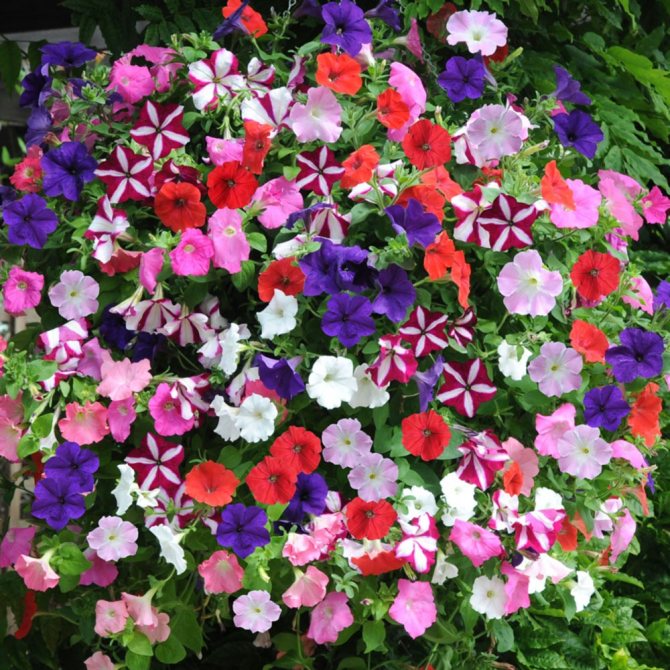

Variety of shades of the Easy Wave range
Easy Wave bloom is very dense, even foliage is practically invisible, different colors bloom at the same time. This allows you to form a variety of multi-color compositions. Height - about 35 cm. Prefers the sun, blooms until the beginning of frost.
Surfinia - a variety series popular all over the world. It grows quickly, is not afraid of adverse weather conditions. The flowers of the plant are large, have a variety of colors: white, purple, blue, red, purple and others. It grows up to 70 cm. The flower prefers sun or partial shade.
Surfinia in a hanging planter
Surfinia is most often planted in hanging or floor pots. Less often it is grown directly in the open field. One of the newest varieties in the Surfinia series is the Table Yellow variety. These petunias are perfectly combined with other ampelous forms. The flowers are small and stand out with yellow veins.
Surfinia Table Yellow
Shock Wave - another ampelous variety from the Wave series. Differs in small sizes of flowers and leaves. The variety is not afraid of rain or wind. Grown in floor and hanging containers, sometimes outdoors. For cultivation for one plant, you need to take about 8 liters of soil. Colors: white, blue, pink, yellow.
Petunia Shock Wave in a hanging planter
Opera Supreme Is a Japanese ampelous petunia. The length of daylight hours for this variety does not matter. Growing is not particularly difficult. The flowers are medium-sized. The plant forms whips up to 1 meter long.
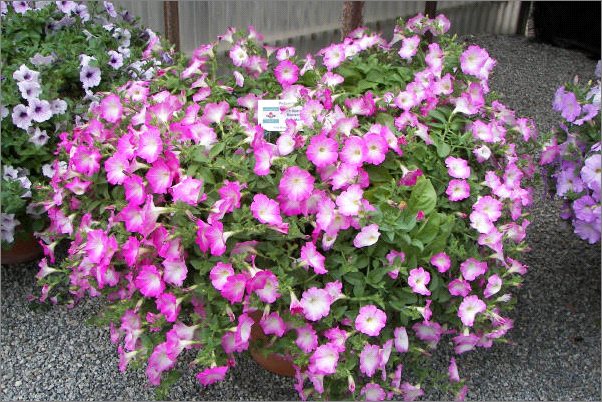

Opera Supreme in a floor pot
Looks great on balconies and hanging vases.Sometimes it is grown in the open field. For one plant, you need to take about 8 liters of soil. In order for the flowering to be abundant, regular plant feeding and the removal of wilted shoots are necessary. The colors are varied: white, blue, pink, purple and others.
Vegetative
Vegetative plants are those that reproduce exclusively by cuttings... Cuttings are brought to Russia from various countries, for example, Holland and America.
The root system of these flowers is small. The shoots grow into large, colorful caps and look great in floor and hanging planters.
The best varieties
CardinalIs a vegetative cultivar. The flowers have a rich purple color. The edges of the petals are slightly corrugated. The cardinal begins to bloom early. Flowering continues until frost. Resistant to adverse conditions. The growth is very vigorous, the flowering is abundant.
Cardinal
Papaya differs in incredible abundant flowering, leaves are practically invisible. Height is about 20 cm. Numerous orange flowers form a cap. All summer until late autumn pleases the eye with its flowering.
Papaya
Cascadias Rim differs in simplicity of reproduction and unpretentiousness. The foliage is very dense. Cascadias Rome is distinguished by abundant flowering. This decorative culture visually resembles a dense spherical bush.
Cascadias rim
Possible problems and diseases
The most common pests and diseases for petunias are:
- Aphid. The main symptoms of the appearance of aphids are leaf deformation, wilting. It can be diagnosed by the appearance of shiny dew. In such cases, it is necessary to treat the plant with special agents (for example, Aktara, Taran, Kemifos).
- Whitefly. It appears on the lower parts of the leaves and resembles a moth. It leads to wilting and yellowing of the leaves. They treat whitefly with Taran or Aktara.
- Spider mite. The leaves of the affected plants brighten and subsequently become covered with dark spots. To combat the tick, they are treated with Demitan or Apollo.
- Powdery mildew. Plants affected by this disease are covered with a white bloom. New leaves grow twisted, and old ones fall off. The main reason for the appearance of the fungus is improper watering. Plants are treated with fungicides (Forecast, Vitaros, Previkur).

